Text
Analytical Application 1
Culture industry:
The culture industry includes many facets of our society, such as popular media and entertainment. Horkheimer and Adorno theorize that the culture industry was created with consumers in mind, hence why it is accepted with little resistance.[1] They also mention how technology has become a huge driving force in the control of those with less power in society. “Technical rationality today is the rationality of domination.”[2] Without the power of technology, the culture industry has less dominance over society.

The Amazon Alexa advertisement is the epitome of the culture industry at large, especially as it goes to show that technology is now a large part of what keeps the culture industry going. Having celebrities, especially these celebrities whose names are brands, act as the voice behind the product is an incredibly accurate way of depicting the culture industry, however accidental it may have been. Horkheimer and Adorno also mention the way celebrities are put up on pedestals as idealized versions of regular people that keep the masses dreaming for stardom, which ultimately helps keep the culture industry going.[3] The usage of celebrities to voice Alexa in this ad plays into the idea that celebrities do normal, everyday things just like the rest of us, yet they have achieved this level of success and notoriety that makes them worthy of our attention and respect. The irony of Amazon being the company to use celebrities in order to make their brand seem more down to earth is incredibly blasphemous, especially considering its track record with the environment and labor. Using celebrities like this distracts the audience from these failings, providing viewers instead with hilarious skits featuring well-known celebrities in order to keep the company in good graces with the general public.
Ideological state apparatus:
Ideological state apparatuses are institutions and systems that express certain ideologies, molding and sculpting the minds of those that participate in them. Some examples include schools, churches, family and communications (media and the like). Althusser also notes that “the Ideological State Apparatuses function massively and predominantly by ideology, but they also function secondarily by repression, even if ultimately, but only ultimately, this is very attenuated and concealed, even symbolic.”[4]

The Zazoo condom ad addresses one facet of the ideological state apparatus (ISA): the family ISA. The family is where we learn about the values we should be holding in our society, and what sort of things we should be trying to achieve to be successful later in life. Our family shapes these ideals, one of which being the way we think about raising children. The advertisement shows a father unable to control his son in a grocery store, leading him to think that he should’ve worn a condom instead of having kids. This ad explicitly goes against the general ideas that the family ISA tries to parrot, that raising kids is the most important thing one can do in their life. Perhaps it is because the family ISA covers up all the not so ideal moments, such as the kid throwing a fit in the grocery store, that necessitates an alternative perspective in the form of this advertisement. The no-kids sentiment is growing among people of the younger generations, if not because of direct experiences with children that make them want to put on a condom, then it is because of advertisements like this. The ISA, according to Althusser, often tries to mold our perception of the world into certain ideologies. With this advertisement, Zazoo creates a new kind of ideology previously untouched by the family ISA, that of not raising children—specifically because they’re annoying to work with at times.
Mechanical reproduction:
Mechanical reproduction describes the reproduction of art with technological advancements, such as the printing press to reproduce writing. Benjamin writes of mechanical reproduction, “The situations into which the product of mechanical reproduction can be brought may not touch the actual work of art, yet the quality of its presence is always depreciated.”[5] Though reproduced art may help distribute it to a wider audience, Benjamin’s theory suggests that this reproduced art is “less art” than the original.

The Sainsbury ad addresses mechanical reproduction through its main character, who works at a toy factory and ends up using it to make toy copies of himself. The toy clones are meant to replace the man at work and other places so that he can spend time with his family during the holidays. In the fantasy land of this advertisement, the toys are an acceptable copy of the guy and he is able to be in multiple places at once. However, according to Benjamin’s theory, the copies are a shallow representation of the original, and would ultimately be unable to hold up to the standards of the originals. Should Benjamin have written this ad, it might’ve gone something like this: the man is struggling to do everything, makes clones, they try to do his work but ultimately fail because they can’t do what the original did. The ad attempts to show it greater audience that the mechanically reproduced products are, in fact, able to live up to the original. This shows how advertisements are the cog that keeps the industry going; without advertisements to quell the worries of the people, they might realize that the mass-produced copies are not living up to the standards of the one-of-a-kind original.
Negotiated code:
Negotiated code is a manner of interpreting media that happens underneath the dominant code, typically by those who do not fall under the hegemonic culture. Hall writes, “Decoding within the negotiated version contains a mixture of adaptive and oppositional elements: it acknowledges the legitimacy of the hegemonic definitions to make the grand significations (abstract), while, at a more restricted, situational (situated) level, it makes its own ground rules – it operates with exceptions to the rule.”[6] While readers of the negotiated code are still able to read the code of the dominant position, their ability to read a code that appears outside of that dominance is what gives them the ability to resist.

The Bertlitz ad is an interesting one because it is clearly designed to be as humorous as possible. The comedic timing is on point and doesn’t miss a beat, staying strong until the very end. However, part of what makes it funny is the audience it’s designed for. The general American audience is primed to find this the most funny because of the man’s accent when speaking English and the premise of the ad being life or death. Somehow, those stakes feel funnier because it is poking fun at a person who doesn’t speak English fluently. While a general audience might get a kick out of this ad, there is a large majority of the world that doesn’t speak English fluently or as their first language who likely feel more seen by the man in the ad than anything else. These folks would be participating in the “negotiated code” as put forward by Hall. Despite being able to read the hegemonic definitions, seeing the way that the ad lays out a reason for improving one’s English speaking ability, there is also another way these folks can read the ad, which is the way it makes fun of non-fluent English speakers in a way that insinuates they should be learning how to speak it better. This all ties back to the dominance of English on the global stage, where English is valued over almost every other language spoken and to speak it without an accent is a survival skill.
Ruling class:
The ruling class is generally defined as those with the most societal power and money. Marx and Engels also define the ruling class as those that control ideas. “It is self-evident that they do this in its whole range, hence among other things rule also as thinkers, as producers of ideas, and regulate the production and distribution of the ideas of their age: thus their ideas are the ruling ideas of the epoch.”[7]

The Snickers ad represents the ruling class in a very subtle way through the assumption that the raw strength and power of the Snickers guy is desirable. In this sense, the best attributes of the ruling class are those of the patriarchy: strength, resilience and fortitude in men. The Snickers guy whips up the soccer player into shape who was complaining about an injury—as soccer players tend to do. Here, the audience is being told that those who have power should look and act like the Snickers guy because the strength and resilience he has is what makes him a man, and that is desirable. If the Snickers guy represents the ruling class in shape and form, then he also represents the ruling class as far as their ideas go. He goes forth into the world to put out the ideas he has about masculinity specifically when he sees others not a part of the ruling class abiding by these ideas. The tank he drives crushing the other cars before he even gets to confront the soccer player is a true testament to the lengths the ruling class will go to in order to ensure their ideas are the ones that proliferate through society.
Bibliography:
Horkheimer, Max and Adorno, Theodor W.. The Culture Industry: Enlightenment as Mass Deception. In Dialectic of Enlightenment edited by Gunzelin Schmid Noeri, 94-136. Redwood City: Stanford University Press, 2002.
Althusser, L. Ideology and ideological state apparatuses. In L. Althusser (Ed.), Lenin and philosophy and other essays. New York: Monthly Review Press, 1971.
Marx K. and Engels F. (1970). Ruling class and ruling ideas. In Storey J (ed.) Cultural theory and popular culture: A Reader. 4th ed. Essex: Pearson, 2009.
Benjamin, Walter. The Work of Art in the Age of Mechanical Reproduction. Translated by J. A. Underwood. Penguin Great Ideas. Harlow, England: Penguin Books, 1936.
Hall, S. W. Encoding/Decoding. In S. Hall, D. Hobson, A. Lowe, & P. Willis (Eds.), Culture, Media, Language: Working Papers in Cultural Studies (pp. 63-87). London: Hutchinson, 1980.
[1] Horkheimer & Adorno, The Culture Industry: Enlightenment as Mass Deception
[2] Horkheimer & Adorno
[3] Horkheimer & Adorno
[4] Althusser, Ideology and Ideological State Apparatuses
[5] Benjamin, The Work of Art in the Age of Mechanical Reproduction
[6] Hall, Encoding, Decoding
[7] Marx & Engels, The Ruling Class and the Ruling Ideas
@theuncannyprofessoro
0 notes
Text
Final Assessment

Overview, Methodology, Thesis
The analysis of Watchmen S1:E6 and S1:E8 begins with an understanding of the texts that provide a theoretical framework for such analysis. The first text is Jacques Lacan’s “The Mirror Stage as Formative of the Function of the I,” which theorizes that an infant can recognize itself in the mirror, proving that a sense of self is possible without the language to describe it.[1] This sense of “I” will also be the most authentic self, as language inherently dilutes the idea through inaccuracies in speech. The second text, “Oppositional Gaze: Black Female Spectators,” is bell hook’s work synthesizing Mulvey’s ideas about the male gaze in cinema and viewing it through a Black female perspective. The oppositional gaze, as hooks describes, is choosing “not to identify with either the victim or the perpetrator;”[2] it is a way for Black women to view cinema in an active manner, refusing to be content with stereotyped and victimized representation. Audre Lorde’s “Age, Race, Class and Sex: Women Redefining Difference” is the third text. This work discusses the way Western society separates us by our defining characteristics so that we can categorize ourselves by dominating groups and subordinating groups. Lorde suggests we must recognize our differences in order to overcome our joint struggles, and at the same time we must unlearn the programming inside ourselves as we go about changing the structures and systems around us.[3] Stuart Hall’s “What is this ‘Black’ in Black Popular Culture?” is the fourth text, which highlights the reasons for inaccurate and shallow representation of Black communities in popular culture, despite Black popular culture often being co-opted for the popular culture.[4]
The theories presented in these texts can be used to analyze how well Watchmen portrays the relationships between the Black men and women in S1:E6 and S1:E8. Before I discuss the applications of the theorists to the episodes, I will parse through the commonalities and differences between the ideas each theorist presents. In episode 8, “A God Walks into Abar,” Angela and Doctor Manhattan—in the body of her husband, Cal—get into an argument about free will and agency where Manhattan insinuates and proves that Angela acts in a predetermined way. Angela refuses to accept this reality, and their relationship begins its crumble to an inevitable end. On the other hand, episode 6, “This Extraordinary Being,” highlights the agency June acts upon in her relationship with William, standing firm in her beliefs as she effectively ends their marriage and takes their son with her to Tulsa. The inability to recognize and understand another’s differences results in a breakdown of the relationship, including the misplacement of trust and empathy, which is fundamentally different from the refusal to accept someone’s actions that have a negative impact on the lives of those around them.
Commonalities and Comparisons
The theorists presented discuss common elements in their works, especially concerning identity, awareness and difference. In Lorde’s work, she elaborates on the way Black lesbians find themselves caught between white women’s racism and Black women’s homophobia. She writes how she is “constantly being encouraged to pluck out some one aspect of [her]self and present this as the meaningful whole, eclipsing or denying the other parts of self.”[5] The desire for people to separate themselves based solely on one category of difference in this way is incredibly isolating and deprives them of connection with any other aspect of their identity. This is similar to hook’s statement on Black women’s inability to find themselves represented in cinema because they face objectification from the Black male gaze when there are Black people represented, or they face erasure by white women being upheld as the peak of femininity in film.[6] As a result, Black women are often forced to turn to independent cinema or other ways of looking at films in order to find positive representations, which is where we get the oppositional gaze. In both cases, differences are used to separate and isolate people from connecting with a group that comprises their identity, which forces these isolated groups to the outside of the canon of representation. Lorde covers this, mentioning how Black women often discredit or do not even recognize the contributions of Black lesbians to Black communities. Part of this discrediting comes from pure homophobia, as being mistaken for a lesbian is not an ideal accusation to face.[7] However, part of it is rooted in the patriarchy, with Black women being fearful that Black men won’t pay them attention.[8] This system works intentionally to keep groups that should be working together from standing in solidarity with each other. This can lead to even further divisions between and within marginalized communities, which doesn’t allow for people to work with each other and might lead to poor representations. Hall’s work expands on this idea, as he postulates that the popular culture that comes out of Black communities is somewhat shallow and inauthentic.[9] The popular culture is dominant, which means that culture coming out of marginalized communities is inevitably homogenized, commodified and stereotyped. Popular culture coming out of the Black community, Hall writes, may have drawn upon Black experiences in its creation, but he asks us to “note how, within the black repertoire, style—which mainstream cultural critics often believe to be the mere husk, the wrapping, the sugar-coating on the pill—has become itself the subject of what is going on.”[10] The shallow, inauthenticity should not be our primary focus; instead, we must continue to look for the lived experiences within these representations. Without going beyond the surface level representation, there could result in what Lacan might call an impure “I.” Within his work, Lacan mentions the “ideal I,” which involves the recognition of oneself as a whole being.[11] Where this comes into conversation with Hall is in Black popular culture; if the generalized and inauthentic representation of the Black community is the only representation out there, what becomes of the “I?” Is it always impure because the recognition, even with the purest intentions, is always of a hollow representation?
Differences and Disagreements
Some of the differences between the theorists emerge in how they discuss the structures and systems that dominate our society. In hook’s work, she draws on Friedberg’s idea of identification replicating the structures of power that created these delineations to pose the question: why is feminist film criticism, having claimed to understand the totality of the female identity, “remains aggressively silent on the subject of blackness and specifically representations of black womanhood?”[12] There should be no reason for such aggressive silence, as hooks puts it, but there is a prevalent phenomenon of the most privileged women being the ones receiving the benefits of the activism, typically rich, white women. This idea that mainstream feminism fails to include and advocate for all women is not a new one. Lorde discusses it while also pushing back against the category of Black women that hooks highlights. She writes that Black women often discount or discredit the contributions of Black lesbians because there is a fear that a) they will be accused of being a lesbian, and b) they will be seen as unworthy of support and attention from Black men.[13] Here, there is a clear difference in how those that fall under the identity of Black women find themselves marginalized; hooks acknowledges the exclusion from feminism while Lorde focuses on the divisions that occur between Black women of different sexualities. Lorde also focuses on the idea of ‘difference’ as a way for society to separate its people into different categories, with those in dominant groups having more mobility and power than those in the so-called subordinate groups. She writes, “It is not those differences between us that are separating us. It is rather our refusal to recognize those differences, and to examine the distortions which result from our misnaming them and their effects upon human behavior and expectation.”[14] The way difference has been stigmatized and sensationalized is just one reason why we fail to recognize and come to an understanding about our differences. It is also our refusal to break the patterns laid out by the systems that keep us from connecting, systems that keep those at the top of the difference hierarchy—rich white men—in power. Hall expands on the idea of difference in our postmodern world. He specifically cites the postmodern’s “deep and ambivalent fascination with difference”[15] as a method of co-opting and synthesizing cultures of marginalized groups. As opposed to the inherent discriminatory tactics that the exclusion hooks and Lorde write about, Hall proposes that difference can be seen as a positive thing when it is beneficial for the popular culture. This then results in shallow and inauthentic representation, as Hall later discusses, because the experiences drawn upon are hiding under the surface of whatever representation Black people have in popular culture. Lacan’s idea that the mirror stage is somehow corrupted by the time language factors into our lives contrasts the idea that Hall has about Black popular culture. Though Lacan would have it that there is a stark difference between the inner “I” and the social “I,”[16] Hall concludes that there is, in fact, enough drawn from Black communities regarding Black popular culture that, despite how shallow it may seem, the authentic and lived experiences make it a product of the Black community—however commodified it may be.[17]
Theorists in Conversation about Watchmen
Both scenes from Watchmen that I will analyze consist of arguments between the couples in each episode. Episode 6, “This Extraordinary Being,” shows a righteously angry June protecting her son from his father, having been upset and wronged by his identity as a crime-fighting vigilante.

Episode 8, “A God Walks into Abar,” shows a righteously angry Angela defending her emotions from Doctor Manhattan’s reminders about his powers, having been upset and wronged by his identity as a time-transcending god.

Both scenes portray the way a Black woman advocates for herself in the relationship, refusing to allow her partner to direct her opinions and emotions. Both scenes also end with one member of the relationship leaving the room, simultaneously leaving their partner in shambles. Surprisingly enough, it is the scene set in the 1920s where the woman has more agency in the relationship; June rejects Will because of his commitment—or addiction—to fighting crime behind a mask and face paint, while in the more modern setting, Manhattan walks away from Angela because of her inability to understand his plight and his powers. The main difference is Angela’s inability to reconcile hers and Manhattan’s differences—how they experience time, for example—versus June’s refusal to accept how Will’s actions were becoming detrimental to their lives, including that of their son.
This Extraordinary Being
In “This Extraordinary Being,” the scene consists of what appears to be a long take—the cutting within the scene is primarily used to make it appear as though it is shot in one take. The unnoticeable cutting enhances the speed with which the scene moves along, making it so the camera can pan back and forth between Will and June. The panning motions gradually get slower as the scene goes on, with more lulls in conversation, lingering gazes and drawn out, emphatic lines from June.

The gradual slowing down of the pacing in the scene matches June’s dialogue and actions, showing that she is in control of the scene. When she enters, she interrupts Will wiping off the paint on his son’s face, simultaneously interrupting the instrumental in the soundtrack. When she leaves with her son, Will is forced to come to terms with his actions. If we position the Black woman as the subject of the gaze, hooks rejects Mulvey’s theory of visual pleasure, the ‘active/male’ and ‘passive/female,’ and “Placing ourselves outside that pleasure in looking, Mulvey argues, was determined by a ‘split between active/male and passive/female. Black female spectators actively chose not to identify with the film’s imaginary subject because such identification was disenabling.”[18] June exemplifies this by being the one to leave the relationship, refusing to be seen within the constraints of the male gaze. There is also a lot of emphasis placed on Will and June’s son, Marcus, and the implications his actions have in the scene.
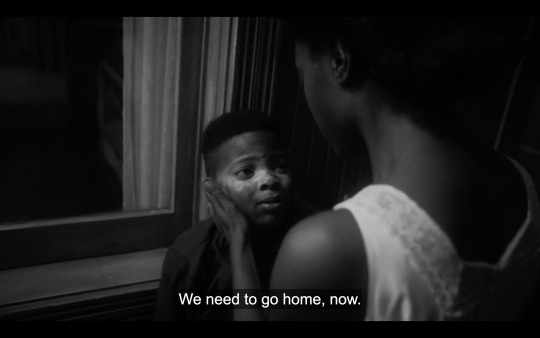
His desire to copy his father is reminiscent of Lorde’s writing about our responses to difference: “Ignore it, and if that is not possible, copy it if we think it is dominant, or destroy it if we think it is subordinate.”[19] Seeing that his father paints his face white and dons a hood every night to fight crime, Marcus identifies that difference and tries to copy it, and this very act is what scares June into leaving Will. He has become so consumed by his alter identity as Hooded Justice that his image of self is unclear. June asks him “Which me?” because she doesn’t know which of his identities is the primal one.
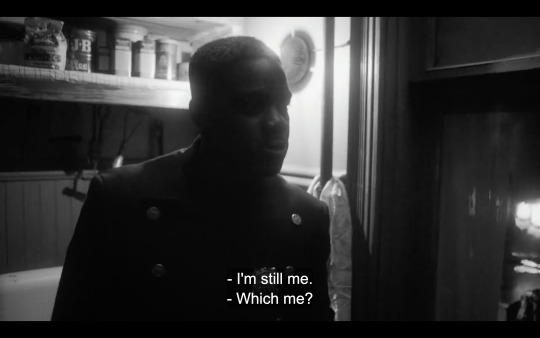
Lacan theorizes that even with a successful dialectical synthesis of the primordial “I” and the discordant image in reality, there is still a difference between these two senses of self.[20] Because Will is unable to grapple with the two identities he balances his life with, his relationships suffer. June is unable to see him for the man she once knew, only seeing the way his vigilante identity has fed the anger that resides deep in his heart. Despite June’s self-advocacy generally being a good thing, her fear that Will’s anger will negatively impact her and her son is a product of what Hall names “aggressive resistance to difference”[21] that occurs during the opening up of society to accept difference. Perhaps it is a result of vigilante crime-fighters becoming more commonplace and less stigmatized that Though it could be that June’s resistance to Will is a result of vigilante crime-fighters becoming more commonplace and less stigmatized, she already resisted Will’s line of work—the police force, just the daytime version of his vigilante activities—because she knew he held onto all of his anger. It is important to consider that June’s resistance to difference comes from a place of understanding how her positionality as a Black woman affects how she moves through the world. Being someone that faces multiple kinds of marginalization, she may find that the best course of action when faced with someone who is filling her life with more hardship is to pack up and leave.
A God Walks into Abar
The scene from “A God Walks into Abar” flips the script and ends with Angela, the woman, being left rather than the other way around. It begins with the two characters having sex as Doctor Manhattan tells Angela about the night they met in the bar, except Manhattan is currently experiencing the moment; for Angela, that moment happened six months ago. Angela is upset when Manhattan tells her about the fight they will get into because she still doesn’t want to believe that it’s true. From here, the scene plays out as a conversation, with reaction shots for each character.
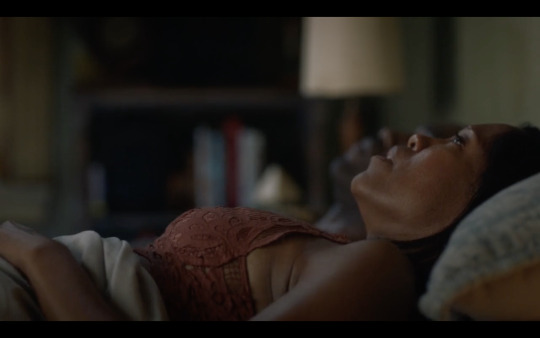
She rolls over in bed because she doesn’t want to hear this from him, the camera alternating depths of field so that only she is in focus. Even when the camera cuts to an angle on the other side of the bed, she is still in focus.
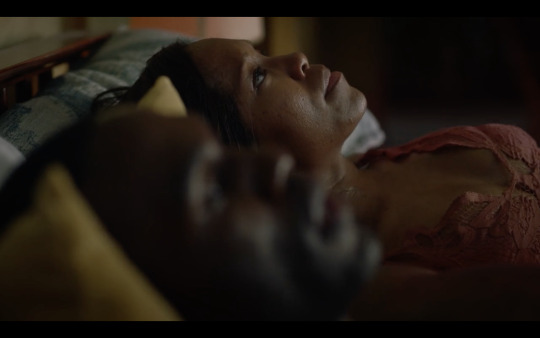
Her side of the story is getting more attention from the camera. However, Manhattan continues to push and push, telling Angela about the fight they’re going to have. It turns out that Angela denying that fight is what spurs it on. The camera no longer focuses its depth of field on Angela, now Manhattan is included in the picture.
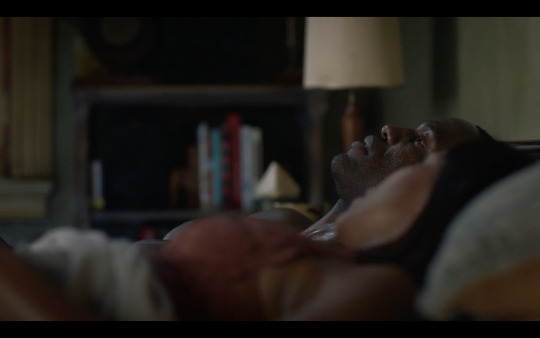
This is literally and figuratively the camera taking focus away from Angela, the woman, in order to focus more on the man’s side of the story. This shift in focus is akin to the shift in power that occurs to ensure cultural hegemony. Hall writes, “It is always about shifting the balance of power in the relations of culture; it is always about changing the dispositions and the configurations of cultural power, not getting out of it.”[22] Though Angela is attempting to assert herself in the relationship, there is a shift in order to maintain cultural hegemony that keeps power away from her and more in the hands of Manhattan.

Both Angela and Manhattan sit up over the course of the argument’s progression, but when Angela sits up, the camera moves position to a low angle, whereas with Manhattan it stays at a neutral angle.

This implies the emotions each character has. From a low angle, Angela’s anger and distrust is apparent, but the neutral angle on Manhattan mirrors the sterilized attitude he approaches his nonlinear experience of time with. Lorde writes about the imbalance that occurs between those with different levels of marginalization. “Traditionally, in american society, it is the members of oppressed, objectified groups who are expected to stretch out and bridge the gap between the actualities of our lives and the consciousness of our oppressor.”[23] The difference in camera angles once the argument exemplifies the way Angela is forced to bear more of the communicative burden in the relationship; she has to do more of the heavy lifting. This puts such a strain on their relationship that eventually boils over at the end of their argument, resulting in Manhattan leaving Angela. His rigidity and unemotional manner of speaking about events he knows will come to pass is part of what angers her.
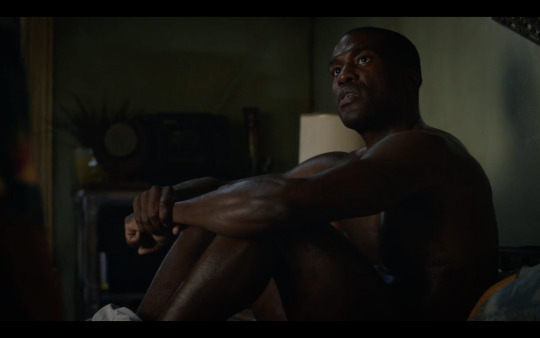
The first shot of Manhattan sitting up is a medium-close shot, but the next reaction shot on him is a close-up, indicating that his side of the story is becoming increasingly important and relevant.

Once they sit up—or stand, in Angela’s case—the over-the-shoulder shots are used more frequently. For the most part, these shots obey the 180-degree rule, which makes the cutting back and forth in the conversation easier to follow for the viewer. However, when Manhattan leans forward, the over-the-shoulder shot on him goes from his right to his left shoulder, allowing his back to take up a majority of the screen. This dominance over the screen also implies his dominance in the conversation, as well as his dominance over her. hooks writes, “In their role as spectators, black men could enter an imaginative space of phallocentric power that mediated racial negation,”[24] which perfectly exemplifies the dominance with which Manhattan is acting upon, leaving no room—literally and figuratively—for Angela’s perspective. In contrast, when there is a shot of Angela’s back turned towards Manhattan, it is done through a medium shot, and she barely takes up a third of the frame.
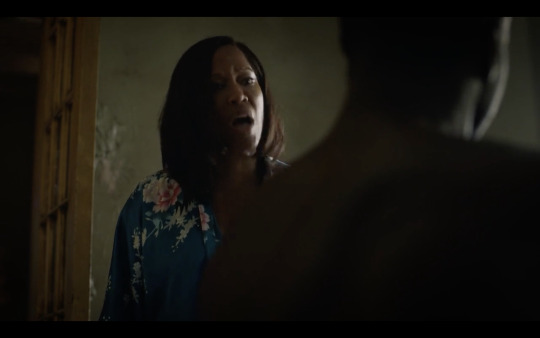
In the last shot of the scene—a medium shot on Angela—Manhattan gets up from the bed and leaves, out of focus in the background. Even though the story has come back to focus on her like it had at the beginning of the scene, she is not the one with agency.

When she advocates for herself, she is shut down, and ultimately is the one to be left, not doing the leaving. Lacan writes about the moment that the “I” goes from inner identification to synthesis with the outwardly perceived identity is the start of personal identities being “mediated by the other’s desire.”[25] In other words, our identity is shaped by those around us rather than coming from within. Angela is exerting this pressure upon Manhattan to conform to humanity since she is intimidated by his abilities, which has damaged their relationship since Manhattan can’t live up to her expectations. Ultimately, it is Angela and Manhattan’s inability to meet each other where they are, in a way that they can begin to understand how to live with each other’s differences that tears their relationship apart.
In Conclusion
To conclude this literature review and application, I would like to affirm that the fact that these two relationships are presented differently is inherently a good thing. If representation were to consist solely of one experience, it would become, as Hall writes, invisibility replaced by “regulated, segregated visibility.”[26] Marginalized groups being represented as a monolith in our popular culture is one of the biggest plagues in the fight for progress as we know it, for there can be no progress if we cannot understand and recognize our differences, as Lorde would have it. June and Angela having different experiences navigating their relationships as Black women is much needed in our media landscape. However, there is something to be said for the way each episode approaches the conflict each woman faces. June is forced to deal with a husband falling deeper and deeper into a workaholic obsession with his night job—fighting crime—to the point that it has begun to seep into every facet of his life. Both parents realize they have to draw the line when their son tries to emulate what his father does, June just so happens to have a drastically different idea of how to draw that line than Will does. Her taking control of the situation is emblematic of refusing to be victim or perpetrator, as hooks writes of the oppositional gaze. Angela, on the other hand, is dealing with someone so different from herself on such a grand scale that these differences are nearly impossible to understand. Though she does have a right to defend herself and stand firm in her beliefs, there is something to be said for her stark refusal to accept these differences between herself and Manhattan leading to her having less of a say in their relationship. Shutting off the connection between the two of them impedes both of their ability to come to an understanding of each other, as they will only be able to see each other for their differences, not as fully realized people. This is precisely the difference between the inner and the social "I" that Lacan writes about, the synthesis of which would lead to a fundamental understanding of each other. Ultimately, we are bettered by our understanding of each other’s differences, and we must strive to endeavor to hold our differences in high regard when moving through our society that so desperately wishes to tear us apart. Only when we are united, fighting against all our collective struggles, can we begin to build a society without a hierarchical system based on which identities are seen as valuable or dominant and which ones are not, where difference can simply exist as a defining characteristic of a human being.
Bibliography
Hall, Stuart. "Three What Is This “Black” in Black Popular Culture? [1992]" In Essential Essays, Volume 2: Identity and Diaspora edited by David Morley, 83-94. New York, USA: Duke University Press, 2018.
hooks, b. "Oppositional Gaze: Black Female Spectators." In Feminist Film Theory. Edited by Sue Thornham. New York University Press: New York (2009).
Lacan, Jacques. 2006. The Mirror Stage as Formative of the I Function. New York: W. W. Norton & Company.
Lorde, A. 1997. “Age Race Class and Sex : Women Redefining Difference.” Dangerous Liaisons S.
[1] Lacan, The Mirror Stage
[2] hooks, The Oppositional Gaze
[3] Lorde, Age, Race, Sex and Class
[4] Hall, What is this ‘Black’ in Black Popular Culture?
[5] Lorde
[6] hooks
[7] Lorde
[8] Lorde
[9] Hall
[10] Hall
[11] Lacan
[12] hooks
[13] Lorde
[14] Lorde
[15] Hall
[16] Lacan
[17] Hall
[18] hooks
[19] Lorde
[20] Lacan
[21] Hall
[22] Hall
[23] Lorde
[24] hooks
[25] Lacan
[26] Hall
@theuncannyprofessoro
0 notes
Text
Analytical Application 6
Dumbo: stereotype
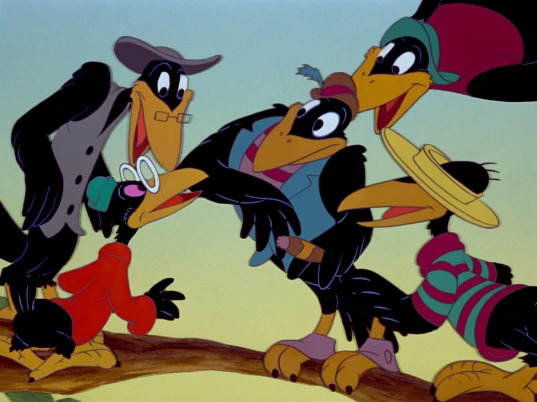
Stereotype refers to actions taken by members of a marginalized group that are presented as representing the group as a whole. In general, stereotypes leave no room for nuanced depictions of members of these communities. Shohat and Stam sum this phenomenon up quite well: “within hegemonic discourse every subaltern performer/role is seen as synecdochically summing up a vast but putatively homogenous community.”[1]
In the clip from Dumbo, the crow characters emulate stereotypes of the Black community. Their voice actors—all of whom are white—speak in a way that both mimics and mocks the accent of Black Americans during the time period. One might even consider this act as the vocal version of blackface. A white person acting how they imagine a Black person may act is acting on a stereotype, and only furthers the stereotype by doing this acting. The song the crows sing is also an imitation of Black culture, drawing heavily on jazz and other music styles that came from the Black community in the late 1800s and early 1900s. Though attributing this music style to the Black community rather than repurposing and repackaging it may be seen as a positive thing, the cheap imitation of it only furthers the stereotype of the Black community. Especially when this imitation is presented by the dominant social and cultural group, there is no room for nuance, which Shohat and Stam say contributes to the stereotyping of marginalized communities. As a whole, this scene plays out as a stereotypical caricature with the aim to mock and portray Black Americans in an extremely negative light.
Lady and the Tramp: the Orient
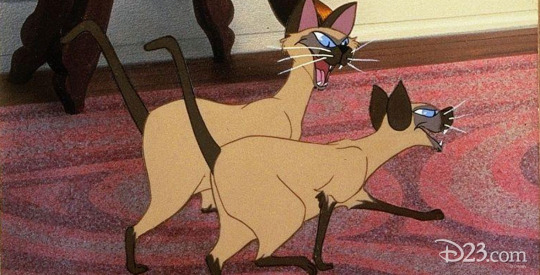
The Orient in Western academia is always described from a perspective of Western colonial power. As Said illustrates in “Orientalism,” Europeans and Americans in the Orient are, in fact, Europeans or Americans first, individuals second.[2] The colonial power identity cannot be separated from the interest in the Orient. Said also points to the purposeful othering of the Orient and its people through the Western portrayal of the West as “familiar” and the Orient as “strange” or “mysterious.”[3]
Using Said’s definition of the Orient as a place that is mystified and othered, it is clear that the portrayal of the Siamese cats in Lady and the Tramp aims to mock and other Chinese people. The features on the cats like the slanted eyes and angular faces is reminiscent of caricatures of Chinese people in American political cartoons and advertisements, which were designed to other, isolate and promote racist ideas against Chinese immigrants and their families. The accent and word choice the cats use in the song also contribute to their othering; the voice actor uses a heavy Chinese accent and words in the song that mock the accents and word choices of native Chinese speakers speaking English. The traditional Chinese musical instruments used throughout the song also add to the othering and mystification of the Siamese cats as they stand out in the soundtrack from all the traditionally Western musical instruments. These factors culminate in a portrayal of characters that are stand ins for “Orientals,” who take on traits of the Orient that Said describes, making it so they are completely othered.
Peter Pan: essentialism
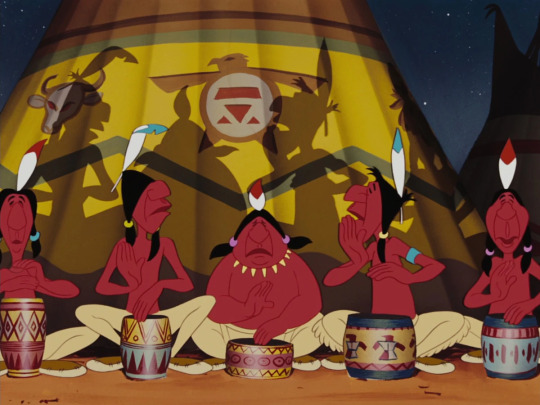
In Hall’s “What is this ‘Black’ in Black Popular Culture,” essentialism is described through the essentializing of difference. “It sees difference as ‘their traditions versus ours’, not in a positional way, but in a mutually exclusive, autonomous and self-sufficient one.”[4] Essentialism in this sense has the purpose of separation, of creating defined lines between certain groups and identities.
The scene from Peter Pan not only relies heavily on stereotypes of Native Americans, but also draws on essentialist ideas about marginalized cultures. Hall writes about essentialism as “their traditions versus ours,”[5] which is shown prominently in the scene through Wendy’s character. She is seen taking away the pipe from her younger brothers—a tradition she does not want them to participate in—and she is consistently put at odds with Tiger Lily, the daughter of the chief that Peter Pan rescued. Because Wendy is white, her ideas about tradition and culture are automatically favored by the viewer because they can see she is from the dominant culture, and it doesn’t help that the Native Americans are portrayed so unfavorably. Throughout the song, the singers accent and word choice are based on racist assumptions that Native Americans speak bad English or are uneducated. The character design of the Native Americans also portrays them as less than the Darlings and the other white characters. Other than their red skin tone—another racist stereotype—the characters are designed with large noses and smaller eyes and uneven-shaped heads. This design choice separates them from the white characters, who all are designed with more realistic proportions. All of these choices, from separating the Native Americans by their traditions to the intentional racist depictions of their character designs, it is clear that this cultural essentialism is used to portray Native Americans in a negative light, adding a racist undertone to a children’s film that the viewer may perpetuate later in life.
The Jungle Book: the Occident
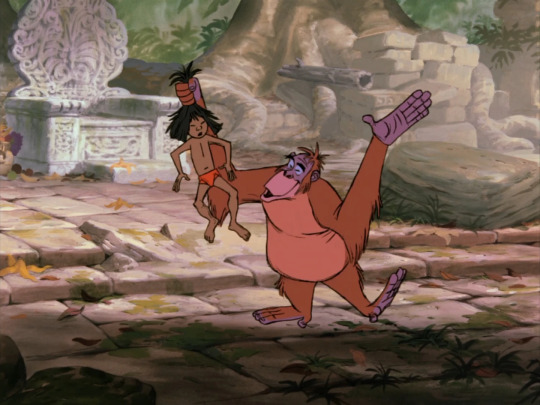
The Occident cannot be defined simply as the counter to the Orient. Instead, as Said describes, “the relationship between Occident and Orient is a relationship of power, of domination, of varying degrees of a complex hegemony.”[6] The distinction made between these two areas always positions the Occident as morally and ideologically superior to the Orient, which warrants the study of the Orient by Occidental colonial scholars.
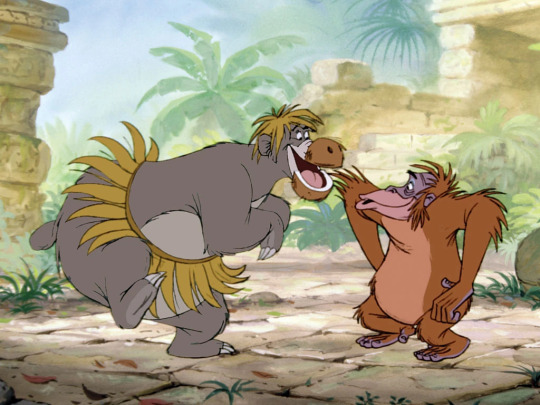
In the scene from The Jungle Book, Mowgli is portrayed as the ideal. The monkeys want to be like him because of the inherent traits he possesses as a human. If we take Mowgli as a representation of the Occident and the monkeys as a representation of the Orient, we can assume that the creators are showing this relationship as an idealization of the Occident and Western culture. This creates a problematic interpretation if we understand that to idealize the Occident through Mowgli is to idealize humanity, implying that anyone in the Orient or just not part of the Occident is somehow less than human and should try to be like Westerners. This reinforces the idea that marginalized groups have to adapt to white dominant culture to be successful. The song also includes the bear and the panther, Mowgli's caretakers and human-adjacent in the narrative, dressing up in costumes to pretend to be the monkeys only as a farce to take Mowgli back, which furthers Said's idea that the European/American in the Orient is their colonial identity first, individual second. This dress up is contingent on the fact that they will cease to be part of the Orient at some point and return to the Occident once they have what they need. This idealization and prioritization of Mowgli shows how the Occident and Western ideas are consistently idealized and prioritized over those of the Orient.

The Aristocats: cultural hegemony
Cultural hegemony can be defined as the sameness or the idealization of one dominant culture. Hall describes cultural hegemony as such: “it is always about shifting the balance of power in the relations of culture; it is always about changing the dispositions and the configurations of cultural power, not getting out of it.”[7] Cultural hegemony is not so much the pure domination of one culture for all of time, but the consistent changes made to the culture that make it appear as though one culture is not dominating, though in reality these changes keep this culture in power.
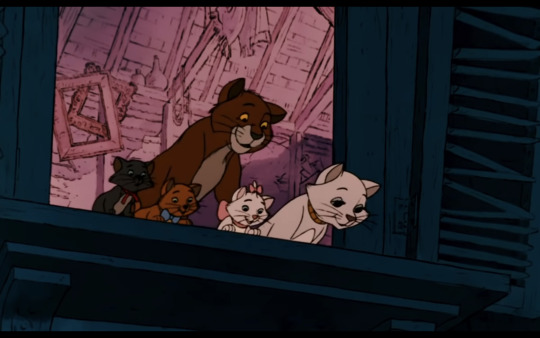
The balance of power, as Hall describes in relations of culture, shifts during the scene in The Aristocats. The scene begins with all the cats in the attic of the house, playing music and singing to their hearts content. However, by the end of the song, the aristocat family watches from the window of the attic as the other musicians fall through the floors of the house and walk out the door with their battered and broken instruments. The cats in the aristocat family are coded to be British or American, the epitome of imperial power. The musician cats are heavily racialized, with caricature-like designs and accents—with a throwback to the Siamese cat design from Lady and the Tramp. With this in mind, the musician cats walking out with broken instruments represents the way shifting culture aims to keep the white dominant culture at the top of the hierarchy, represented by the British and American coded cats staying in the attic—they are high class, literally and figuratively.
Bibliography:
Hall, Stuart. 1992. "Three What Is This “Black” in Black Popular Culture?" In Essential Essays, Volume 2: Identity and Diaspora edited by David Morley, 83-94. New York, USA: Duke University Press, 2018.
Said, Edward W. 2003. "Orientalism." Penguin Modern Classics. London, England: Penguin Classics.
Shohat, E & Stam, R. 1994. "Stereotype, Realism, and the Struggle over Representation." In Unthinking Eurocentrism. Taylor & Francis Group. London: Routledge.
[1] Shohat & Stam
[2] Said
[3] Said
[4] Hall
[5] Hall
[6] Said
[7] Hall
@theuncannyprofessoro
0 notes
Text
Said describes Orientalism in many different ways, but to sum them all up, in general Orientalism is a political vision of reality where the East is pitted against the West in an "us" versus "them" battle.[1] The disadvantage the East has is that any representation of it is coming from the perspective of a Westerner, the outsider looking in and attaching a certain perspective or value to what they see. Often, this results in the Orient being perceived as "irrational, depraved, childlike and different," and Europe, the US and the West being perceived as "rational, virtuous, mature and normal."[2] When linking to film, television and popular media, this intentional othering means that representations of the East and its people end up being just that: representations. There can be no "natural" depiction because there is no self-representation. Said brings this idea back to the sentiment of many Western Orientalist scholars/artists, who believe that "if the Orient could represent itself, it would."[3] Since it cannot (or never has the opportunity because of the emphasis on the Western "canon" of history and society), the interpretations and representations created by Western society will have to do. Having such a prevalent standards of accepted stereotypes entirely based on the interpretations of outsiders means that the field of Orientalism only exists because of the culture that produces it, not necessarily because of the inherent mystery "the Orient" presents to the West. From my understanding, Orientalism is not interested in being a field with accurate/authentic representations because that goes against the political purpose of the field, which--as Said puts it--is to "understand and control a 'different world'."[4]
The use of stereotypes in film and television can have positive and negative effects. They are useful in helping those from underrepresented groups identify with experiences shown onscreen. They attempt to unify a group under certain actions or traits, which can also be a detriment to the representation of these groups of people offscreen. Film and television are powerful mediums because they add visual elements to the dialogue that goes on between people in their everyday lives, which also means there is an expectation of what people will be seeing when they watch a piece of media. Shohat and Stam say that cinema doesn't "refer to or call up the world so much as represent its languages and discourses."[5] This artistic discourse is a "refraction of a refraction,"[6] the reproduced idea rather than the original. This is good for storytelling, as it functions as a vessel for subtlety and allegory, but when it comes to authentic and accurate representation of historically misrepresented groups, these layers distort the representation and disconnect the stereotype from the lived experience until it becomes disingenuous representation.
@theuncannyprofessoro
Bibliography:
Said, Edward W. 2003. Orientalism. Penguin Modern Classics. London, England: Penguin Classics.
Shohat, E & Stam, R. 1994. "Stereotype, Realism, and the Struggle over Representation." In Unthinking Eurocentrism. Taylor & Francis Group. London: Routledge.
[1] Said
[2] Said
[3] Said
[4] Said
[5] Shohat, Stam
[6] Shohat, Stam
Reading Notes 10: Said to Shohat and Stam

To wrap up our studies of visual analysis, Edward W. Said’s “Orientalism” and Ella Shohat and Robert Stam’s “Stereotype, Realism, and the Struggle Over Representation” provide critical paths to understanding the roles of race and representation play in our production and consumption of film, television, and popular culture.
How is orientalism linked to film, television, and popular media, and in what ways has standardization and cultural stereotyping intensified academic and imaginative demonology of “the mysterious Orient” in these mediums?
What role do stereotypes play in the representation of people, and in what ways can film and television change the perception of cultural misrepresentation?
@theuncannyprofessoro
15 notes
·
View notes
Text
Gender and Sexuality Analytical Application
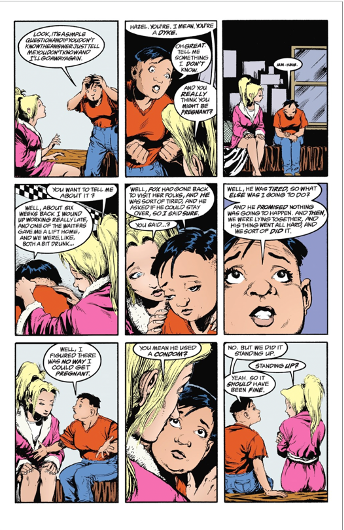
Butch:
Butch is a specific label within the identity of ‘lesbian.’ Typically, we understand ‘butch’ as a masculine woman, but this identity also functions as an identifier for other lesbians. Halberstam writes that “the butch stereotype, furthermore, both makes lesbianism visible and yet seems to make it visible in nonlesbian terms: that is to say, the butch makes lesbianism readable in the register of masculinity, and it actually collaborates with the mainstream notion that lesbians cannot be feminine.”[1] Due to this, the butch turns into a stereotype of the lesbian community rather than a subset of lesbianism. There are certain roles and acts that butches are allowed, and others that they are not, otherwise they risk breaking the mold set by society’s assumptions about the people behind the label.
In the above page from The Sandman: A Game of You by Neil Gaiman, there is a subversion of the stereotype of butches with the character of Hazel. When the reader sees Hazel, the visual cues lead them to believe that she is a stereotypical butch upon first look. And indeed she is a butch. What this page does magnificently is disrupt the hyper-masculine image of a butch lesbian by having Hazel come to her friend Barbie—a feminine straight woman—about possibly being pregnant. This question shakes up Barbie as well as the reader; two panels are devoted to Barbie rationalizing that Hazel had sex with a man in the first place. Due to the stereotype of butch lesbians being hyper-masculine and also typically having femme partners, the idea of Hazel with a man is an inherent disruption of the stereotype. By allowing a butch to act beyond what the stereotype dictates, A Game of You sets up Hazel as a butch that does not conform to the norm. Breaking out of this stereotype is important for butches, as it will allow the other identities within the lesbian community that are constructed around ‘butch’ to break away from butch and construct their own multifaceted identities as lesbians.

Male gaze:
The male gaze relates how women are viewed by men, specifically in film. There is an aspect of fantasy to the male gaze, which projects its desires onto the female figure. Mulvey states, “women are simultaneously looked at and displayed, with their appearance coded for strong visual and erotic impact so that they can be said to connote to-be-looked-at-ness.”[2] There is little agency for women in the male gaze because their bodies and actions are dictated by what the man viewing them wishes.
The above panel of The Sandman: The Doll’s House shows part of the tale that men in the community tell each other through generations. The composition of the panel shows the tale in the larger square panel, then the older man who is telling the tale in four skinnier panels below. The man in the tale—Dream—and the old man in real life are drawn from the same low angle, where Dream watches Nada, his love, throw herself off a cliff instead of choosing to stay with him. The parallel between Dream and the old man connects the men that tell the tale in the community to the main male character in the tale, solidifying Dream as the self insert character for men. This is interesting because Nada is set up as the main protagonist of the tale, and despite having more agency than Mulvey would describe women having under the male gaze, she is still a prize to be won by Dream within the story. However, with the rest of the context of this issue, the narrator tells the reader in text boxes bracketing the beginning and end of the comic that there are two versions of this tale circulating: the one the men tell each other—the one we the readers are told—and the one the women tell each other in a secret language the men do not dare to learn. By leaving out the women’s tale, The Doll’s House positions the reader with the men of the community, and by proxy, Dream. We are forced to participate in the male gaze by pure omission of the women’s side of the story, completely intentionally. Perhaps this was done to emphasize the lack of agency women have in telling their stories under the male gaze.
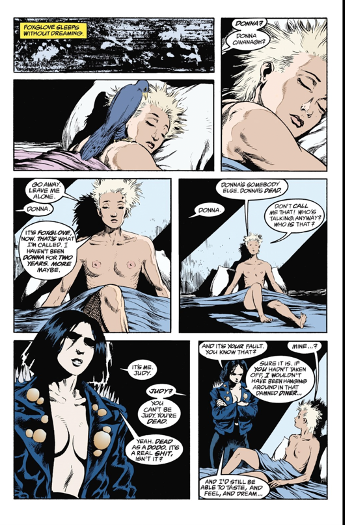
Queer gaze:
The queer gaze is in direct opposition to any gendered gaze that has been used to analyze cinema thus far. There is a tendency for psychoanalytical theories of viewing to be strictly gendered, and as the queer gaze rejects the gendered aspect of this type of viewing, it also rejects the more psychoanalytical aspects as well. Halberstam writes about the queer gaze in relation to Mulvey’s thoughts on the male gaze, calling for new terms with which to discuss cinema that were previously unimaginable, avoiding psychoanalytic terms. “Queer cinema, with its invitations to play through numerous identifications within a single sitting, creates one site for creative reinvention of ways of seeing.”[3]
Through this page of The Sandman: A Game of You, Neil Gaiman depicts two women in a way that forces the reader to view them through the queer gaze. Subversions of typical gender norms cue the reader into the queer reading, but again it is the composition that aids the reader the most. The two panels in the middle of the page show the naked form of one of the characters, Foxglove. The angle is straight on, betraying no emotion, simply showing her as she is. Under the male gaze, this panel would have been used to sexualize Fox and the female body, but through the queer gaze, she is simply allowed to exist in her natural state. The next couple panels show Fox’s old lover, Judy. The first look we get of her is a low angle where her character overlaps with the border of the panel above. Her presence is already too big to be contained within a single panel, only emphasized by the leather jacket with spikes that enlarges her figure. Despite the clear indicators of femininity to a viewer—breasts showing and a feminine hairstyle—Judy manages to retain aspects of masculinity through her character design, though she isn’t quite ‘butch.’ Due to the subversion of what viewers expect from the male gaze in panels such as these, a less gendered form of viewing emerges from these panels—a queer gaze. Of course, this gaze is aided by the fact that the women were lovers; queerness is explicit and implicit here.

Gender norms:
Gender norms are established concepts or acts that group people into one gender or another. Typically, we see this most within the gender binary: male and female. Butler would have us recognize that such norms under regimes of power are realizable and not realizable. “This 'being a man' and this 'being a woman' are internally unstable affairs.”[4] Gender norms are standardized for those that fall within the gender binary, but they also are designed to be unattainable so that people are always trying to reach for a goal instead of reevaluating the value of such norms under a power regime.
In The Sandman: A Doll’s House, gender norms are upheld through the interactions characters of different genders have. However, they are upheld through nontraditional ways, as the characters do not represent typical archetypes of each gender. In the above panels, the male character Gilbert saves the female character Rose from being mugged in an alleyway late at night. Gilbert embodies standards of masculinity like chivalry, protectiveness and kindness. Though the narrative allows him to show strength—as seen in the topmost left panel having beaten up the would-be muggers—he is not consumed by it as many male protagonists are in action films. Such protagonists may feel entitled to women and their attention having proved their physical prowess, but Gilbert is different. In that aforementioned panel, he is positioned behind the muggers, taking up less than half the panel. His strength is not romanticized, merely used in an act of kindness for Rose. She also adopts some classic tropes of female protagonists, such as being in danger and needing a man to save her. However, her status as ‘damsel in distress’ is more of a right place wrong time type of situation, where luck was on her side that Gilbert showed up to help. Her agency is never diminished; Gilbert even asks her if she wants to kick the muggers, but she responds, “No, no thank you. These are nice shoes.”[5] In the center panel, despite their height difference, Gilbert defers to Rose, bowing his head towards the woman standing tall in front of him. Showing the complexity of how people interact with gender norms proves Butler’s notion that there are attainable and unattainable aspects of gender.

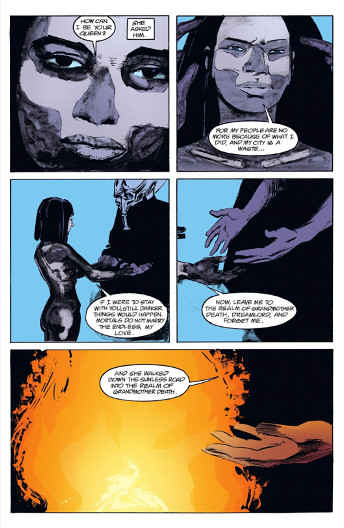
Oppositional gaze:
The Black female oppositional gaze is a form of viewing cinema that Black women utilize in order to see themselves represented onscreen without negative racialized or sexualized representations. In bell hook’s work, she writes that Black women “saw cinema's construction of white womanhood as object of phallocentric gaze and choose not to identify with either the victim or the perpetrator.”[6]
I chose two sets of panels for this term because I believe the first exemplifies the erasure of Black women and therefore the oppositional gaze, while the other represents Black women havin agency over their lives and stories, a direct installation of the oppositional gaze. The text boxes in the first panel detail the two different stories that are told in one Black community: the one passed generation to generation by men, and the other by women. We are never explicitly told the women’s versioni of the tale in the issue, which is a direct denial of the oppositional gaze. Without even being shown a single Black woman outside of the visualization of the tale the men tell each other, how can one even use the oppositional gaze? This is why the second set of panels is important; it gives Black women an opportunity to use the oppositional gaze, which is incredibly necessary since this story is being told by a man. Within the panels, the female protagonist Nada refuses to be Dream’s lover because of the consequences that fell upon her people when she slept with him once. He had threatened her with an afterlife of eternal damnation should she refuse him, yet in this set of panels, Dream does not speak. Only Nada speaks, asserting her beliefs and values before walking away from Dream and into the arms of Grandmother Death. This exemplifies hook’s assessment of the necessity of the oppositional gaze where Black women do not identify with the victim or perpetrator.
[1] Halberstam, Looking Butch
[2] Mulvey, Visual Pleasure
[3] Halberstam, Looking Butch
[4] Butler, Gender is Burning
[5] Gaiman, The Sandman: A Doll’s House
[6] hooks
Bibliography:
Butler, J. 1999. "Gender is Burning: Questions of Appropriation and Subversion." In Feminist Film Theory. Edited by Sue Thornham. New York University Press: New York.
Gaiman, N. 1989. "A Doll's House." The Sandman. DC Entertainment: Burbank.
Halberstam, J. 1998. "Looking Butch: A Rough Guide to Butches on Film." In Female Masculinity. Duke University Press: United States.
hooks, b. "Oppositional Gaze: Black Female Spectators." In Feminist Film Theory. Edited by Sue Thornham. New York University Press: New York (2009).
Mulvey, L. 1975. "Visual Pleasure and Narrative Cinema." In Film Theory and Criticism. Edited by Leo Braudy and Marshall Cohen. Oxford University Press: New York/Oxford (2009).
@theuncannyprofessoro
0 notes
Text
Halberstam's example of a Latina butch in the movie Aliens (1986) is fascinating because it exemplifies the "positive image" that is rooted in pushing back against a conservative agenda. They write about the tough comeback as it "denaturalizes gender and literally returns the gaze, refusing to allow the white soldier to claim the place of universality and indeed humanity. Vasquez's butch performance hints at an "alien" logic of gender within which masculinity is as much a production of ethnicity as it is of gender and sexuality."[2] Though Vasquez is allowed to assert herself as a Latina and a butch, the film dictates that this identity of many marginalizations is too complicated, too confusing, for the popular culture, as she is the first victim of the film. Further marginalizing Latina butches, a Latina actress was not playing this role; instead, a Jewish actress played Vasquez. Why are Latina butches, who are massively underrepresented in popular culture anyway, further marginalized by not even being allowed to represent themselves onscreen?
One important thing to note with the political site to negotiate various identities in popular culture is the place in which the culture originates. Hall mentions that the shift from European high culture to American mainstream culture also includes the acknowledgement of ethnicities that make up the mainstream culture in the US. "American mainstream popular culture has always involved certain traditions that could only be attributed to black cultural vernacular traditions."[3] It is "America's ambivalent relationship with European high culture"[4] that sets the stage for marginalized identities to be represented and discussed within mainstream popular culture simply because of European high culture's inability to recognize the ethnic identities within it (up until very recently). But taking into account postmodernism's obsession with difference, Hall writes that there is also an "aggressive resistance to difference; the attempt to restore the canon of western civilization,"[5] which of course means white popular culture. By asserting itself as the dominant race, whiteness also pervades into our popular culture, shifting not just the narrative of culture but the lens through which we view it.
[1] Halberstam
[2] Halberstam
[3] Hall
[4] Hall
[5] Hall
Bibliography:
Halberstam, Jack. "6. Looking Butch: A Rough Guide to Butches on Film" In Female Masculinity, 175-230. New York, USA: Duke University Press, 1998. https://doi.org/10.1515/9780822378112-008
Hall, Stuart. "Three What Is This “Black” in Black Popular Culture? [1992]" In Essential Essays, Volume 2: Identity and Diaspora edited by David Morley, 83-94. New York, USA: Duke University Press, 2018. https://doi.org/10.1515/9781478002710-007
@theuncannyprofessoro
Reading Notes 9: Halberstam to Hall

Jack Halberstam’s “Looking Butch: A Rough Guide to Butches on Film” and Stuart Hall’s “What is this ‘Black’ in Black Popular Culture?” link our inquiries into gender and sexuality with race and representation.
What examples of “positive images” of marginalized peoples are in film and television, and how can these “positive images” be damaging to and for marginalized communities?
In what ways is (popular/visual) culture (performance) a complicated and political site where various identities are negotiated, and how can cultural strategies make a difference and shift dispositions of power?
@theuncannyprofessoro
15 notes
·
View notes
Text
Power and privilege clearly play a role in how people who are oppressed in different or compounding ways interact with each other. In "Age, Race, Class and Sex: Women Redefining Difference," Audre Lorde describes how Black queer women are often shunned by both white women and Black women, though for different reasons. She says they are "caught between white women's racism and Black women's homophobia."[1] It is due to the way white women are allowed to interact with the privileges of the patriarchy because of their proximity to whiteness, and the deeming of queerness as "un-Black"[2] that causes Black women to separate themselves from Black queer women. These power structures inform how each group sees the other's differences. Lorde writes that we must begin to undo the structures implanted in our minds while also bringing down the institutions in our society in order to build new ones that allow our differences to be seen and accepted rather than ignored or destroyed.[3]
There are a variety of representations that support gender performativity, such as the color-coded toys we buy for our kids, appropriate hairstyles for each gender (this varies by culture, of course), and the tropes and stereotypes we see actors performing in film. Judith Butler says in her work "Gender is Burning: Questions of Appropriation and Subversion" that it is due to the repeated acts done by people attempting to emulate a gender that actually creates the illusion of this gender.[4] With this, she also asserts that there is no such thing as a "natural" man or woman; rather, we have created this strict binary for ourselves--which is funny because the rules we must follow for each gender change every so often. Butler then continues on to say that heterosexuality, like gender, is "a constant and repeated effort to imitate its own idealizations."[5] In this sense, the natural order of the world, as dictated by a hegemonic heterosexual society, is also an imitation of what is thought to be "correct" or "societally acceptable."
Bibliography:
Lorde, A. 1997. “Age Race Class and Sex : Women Redefining Difference.” Dangerous Liaisons S.
Butler, J. 2000. "Gender is Burning: uestions of Appropriation and Subversion." In Feminist Film Theory. Edited by Sue Thorman. p. 336-348.
[1] Lorde, "Age, Race, Class and Sex"
[2] Lorde, "Age, Race, Class and Sex"
[3] Lorde, "Age, Race, Class and Sex"
[4] Butler, "Gender is Burning"
[5] Butler, "Gender is Burning"
[6] Butler, "Gender is Burning"
@theuncannyprofessoro
Reading Notes 8: Lorde to Butler
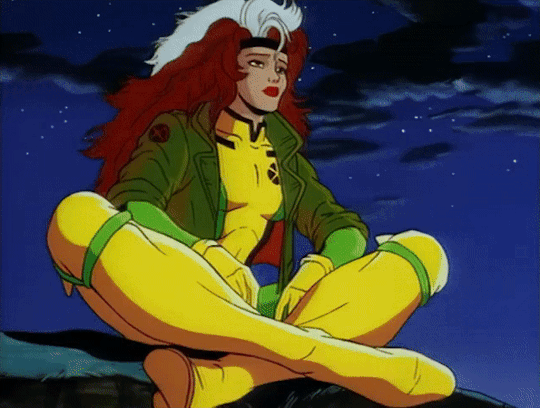
In our continued discussions, Audre Lorde’s “The Master’s Tools Will Never Dismantle the Master’s House” and “Age, Race, Class, and Sex: Women Redefining Difference,” and Judith Butler’s Gender is Burning: Questions of Appropriation and Subversion” provide further introspection into systems and definitions of gender and sexuality.
How do power and privilege impact the relations people have with each other and with institutions, and how can we acknowledge, examine, and remedy oppression and marginalization using oppressive and marginalized systems?
How do cultural, societal, and media representations support gender performativity and in so doing complicate gender norms, and in what ways is heterosexuality a performance?
@theuncannyprofessoro
17 notes
·
View notes
Text
Mulvey begins her work by establishing that patriarchy and its ideology unconsciously influences film. Because women are subjugated and often reduced to vessels of sexual pleasure and reproductivity in a patriarchal society, it makes perfect sense that, as Mulvey puts it, "the paradox of phallocentrism in all its manifestations is that it depends on the image of the castrated woman to give order and meaning to its world."[1] Mulvey also writes that women are objects of male fantasy, forced to bear meaning rather than make it.[2] All these analyses point to the objectification of women under the male gaze, which does not allow a woman agency or mobility in the world around her.
Mulvey also articulates that Hollywood and other mainstream film has "coded the erotic into the language of the dominant patriarchal order,"[3] which only amplifies the already prominent male perspectives in society within the art form of cinema. With women as the 'passive' and men as the 'active,' the audience is able to align themselves more with the male gaze since the male protagonist is the one leading the plot.[4] This order always subjects women to the male gaze and displays their bodies, whether the full thing or just bits and pieces made to look erotic on camera, in such a way that they are made to be looked at, never the ones doing the looking.
Because film at its inception was created to uphold a white supremacist system, black viewers "experienced visual pleasure in a context where looking was also about contestation and confrontation."[5] It was then the oppositional gaze that responded to that by developing independent black cinema.[6] But there are differences between how black men and black women view cinema, according to hooks. "In their role as spectators, black men could enter an imaginative space of phallocentric power that mediated racial negation."[7] Due to this, black women less often found themselves relating or even seeing something resembling themselves or their experiences on the silver screen. To describe this phenomenon, hooks writes that black women "saw cinema's construction of white womanhood as object of phallocentric gaze and choose not to identify with either the victim or the perpetrator."[8] This is the development of the oppositional gaze, something that empowers black women to construct her worldview onscreen outside of the white patriarchal default cinema ascribes to.
[1] Mulvey
[2] Mulvey
[3] Mulvey
[4] Mulvey
[5] hooks
[6] hooks
[7] hooks
[8] hooks
Mulvey, L. (1975). Visual Pleasure and Narrative Cinema. Screen, 16, 6-18.
hooks, bell. The Oppositional Gaze: Black Female Spectators. South End Press, 1992.
@theuncannyprofessoro
Reading Notes 7: Mulvey to hooks

Shifting our visual analysis and critical inquiries to gender and sexuality, we will begin our explorations with Laura Mulvey’s “Visual Pleasure and Narrative Cinema” and bell hooks’s “Oppositional Gaze: Black Female Spectators.”
How does the spectacle of the female image relate to patriarchal ideology, and in what ways do all viewers, regardless of race or sexuality, take pleasure in films that are designed to satisfy the male gaze?
How do racial and sexual differences between viewers inform their experience of viewing pleasure, and in what ways does the oppositional gaze empower viewers?
@theuncannyprofessoro
16 notes
·
View notes
Text
Analytical Application 4
Collective Catharsis:

In Fanon’s work, “The Negro and Psychopathology,” he describes collective catharsis as “an outlet through which the forces accumulated in the form of aggression can be released.”[1] What is truly incredible is that catharsis can be achieved through multiple means: games, therapy, even watching film and television.
In the X-Files episode “Squeeze,” there is a fairly straightforward example of such a catharsis. When the old sheriff picks up his newspaper and reads the story about Toomes being arrested and sentenced, it brings about a look of incredible relief and joy on his face (Longstreet, 1993, 39:45). For so long, he had been obsessed with catching Toomes that he nearly ruined his career by continuing to pursue the case. This moment of realization that he can rest easy knowing that what he set out to do was accomplished has a cathartic aspect to it because it was set up earlier in the episode (Longstreet, 1993, 26:57). Without the context for his continued chase of Toomes, the relief he feels having seen his arrest wouldn’t have been nearly as impactful for the viewer. This setup and payoff is required to effectively tell the story because it wouldn’t be as cathartic if the viewer wasn’t as invested in experiencing that catharsis as well.
Unheimlich:

The unheimlich is the opposite of the heimlich, which is the German word for ‘familiar.’[2] It also describes the hidden or unknown state of things. Freud describes heimlich as a word that develops an ambivalence, until it coincides with the unheimlich, which is not entirely understood.[3] For this reason, the unheimlich is an important part of what makes something uncanny.
The unheimlich in the scene where a man is murdered around halfway through the episode (Longstreet, 1993, 20:27) shows itself in the way the scene resembles the opening scene. There, the murder of the man is played like a straight up serial murder, but with the added context of the investigation from the part of the episode that has happened already, the heimlich or ‘familiar’ parts of the murder start veering closer and closer to intersecting with the unheimlich. These elements appear specifically with the showing of Toomes’ supernatural abilities—think the way he squeezes himself down the chimney (Longstreet, 1993, 22:01). Though we have already seen this before—it was even the same sort of older business man getting murdered—there are subtle differences that push our understanding of it to unfamiliar territory. Also, the familiar parts of the setting are made unfamiliar by way of the audience knowing that Toomes will appear at some point to murder the man. Each corner could hide a murderous man, and the fireplace, once a place of warmth and comfort, could hide Toomes’ glowing eyes in its shadows. This aspect of unheimlich transforms this scene in a way that doesn’t make it feel repetitive, as it is essentially the same as the opening murder scene.
Uncanny:

In his work “The Uncanny,” Freud puts forth a few ways to define the word ‘uncanny.’ He describes it as “that class of the terrifying which leads back to something long known to us, once very familiar,” which arises out of our repressed memories.[4] This is where the unheimlich, or ‘unfamiliar’ comes in; that which is unfamiliar but is now being brought to the surface of our minds is what makes something feel uncanny.
During the X-Files episode “Squeeze,” the unheimlich appears during the part of the episode where Scully (Gillian Anderson) and Mulder (David Duchovny) go to investigate the old apartment where Toomes supposedly lived in the early 20th century (Longstreet, 1993, 30:16). The main room of the apartment definitely has a creepy vibe—in the way that abandoned rooms in abandoned buildings usually do—but it’s not quite uncanny. This lack of uncanny vibe is remedied when the characters travel underneath the building into what can only be described as a lair. The surroundings underground are covered in newspaper clippings that have been spit-balled onto the walls, and the artifacts and personal effects that Toomes takes from his victims are enshrined in the center (Longstreet, 1993, 32:06). It is these household and personal items that truly add to the uncanny feeling of Toomes’ lair. Surrounded by all this grime and grossness, coupled with the horrific fact that the two main characters are in the belly of the beast, so to speak, the personal items lend that familiarity, that “once very familiar” aspect that Freud mentioned.[5] These items tie the creepy supernatural setting and story back to a grounded place in reality, which is what elevates the creepy vibe into an uncanny one.
Mirror stage:
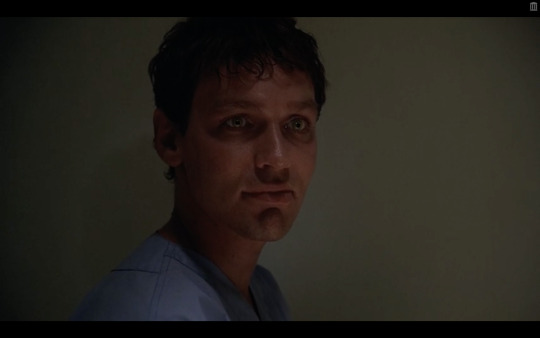
The mirror stage was theorized by Lacan in his work, “The Mirror Stage as a Formative Function of the I.” In the text, Lacan describes how an infant, before being able to walk or talk, can recognize itself in the mirror and can understand that the image it is seeing is indeed itself.[6] This is the first instance of the I that humans can understand, and it is the purest form of the I since it cannot be diluted with words since the infant has no grasp of language.
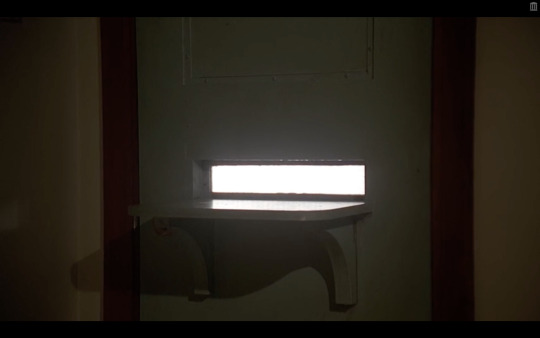
One of the scenes towards the end of the episode exemplifies the mirror stage quite well. Once Toomes has been imprisoned, a guard comes to give him food, sliding it through a little opening in the door. Toomes immediately latches onto this opening as a sign of hope, with the POV shot showing the opening as a bright white light, almost like an escape into a different world (Longstreet, 1993, 41:04). With Toomes’ supernatural powers, that opening very well could be the way he escapes. However, I relate this to the mirror stage because, despite the lack of a mirror, seeing the opening awakens a primordial realization in Toomes, one that resembles that of an infant seeing itself in the mirror for the first time and realizing the reflection is itself. Toomes’ supernatural powers are certainly a core tenet of his being, and so seeing an opening where he can use those powers in an otherwise baren room might feel like the pure I that Lacan mentions when an infant sees its reflection.
Disalienation:
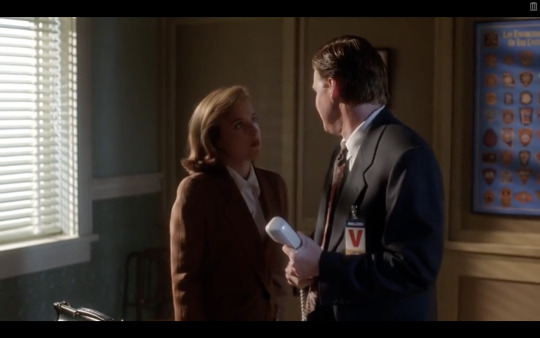
Fanon proposes the method of disalienation as an opposition to the common practice of alienation. In disalienation, race relations might cease to exist, and people will look at each other and focus on understanding one another.[7] Disalienation begins with a blank slate where two races can interact with each other, this blank slate being a product of the histories of the two groups.
Though there are no characters of color in the episode of the X-Files, the concept of disalienation could potentially be applied to the different branches of the FBI. There is the branch that handles most crimes, and the branch that Mulder and Scully are a part of, the supernatural branch. Throughout the episode, the disdain that other investigators hold towards the supernatural branch is made clear—they think Mulder in particular is “spooky” (Longstreet, 1993, 7:00)—and it complicates the way the case gets solved. Fellow FBI agent Tom Colton with the “normal” branch even goes so far as interfering with Mulder’s stakeout because he doesn’t believe that he should get the credit. However, in the scene where Colton tells Scully that he recalled the men on the stakeout, she stands up for Mulder and reasserts herself as a prominent member of the supernatural branch (Longstreet, 1993, 34:54). I would say this moment where Scully, who was drifting away from Mulder and the supernatural branch at the beginning of the episode, comes into her own and rebuffs her identity as part of the supernatural branch is the starting point to create the blank slate where the two groups may be able to interact.
[1] Fanon
[2] Freud
[3] Freud
[4] Freud
[5] Freud
[6] Lacan
[7] Fanon
Bibliography:
Fanon, Frantz. 2008. Black Skin, White Masks. London: Pluto Press.
Freud, Sigmund. 1925. The Uncanny. Toronto: Oxford University Press.
Lacan, Jacques. 2006. The Mirror Stage as Formative of the I Function. New York: W. W. Norton & Company.
@theuncannyprofessoro
0 notes
Text
Uncanny to me is a feeling that emerges when I see something that looks right but feels wrong somehow, but I can't quite put my finger on what. Freud would say that the uncanny harkens back to old memories--"that class of terrifying which leads back to something long known to us, once very familiar."[1] That creepy-unfamiliar feeling manifests as a morbid form of anxiety that comes from repressed memories of our past. An experience that appears to be uncanny might be something creepy and unfamiliar but not rooted in those repressed memories.
A personal neurosis occurs when the mind cannot truly begin to process the differences between the many images of the human it is attached to from different outputs. The "ideal-I" becomes separated from how the person can express themselves with words.[2] But this separation becomes less unbearable when put in contact with social passions, which can distract from the moral dilemma between the "ideal-I" and the "social-I."
Marginalized viewers are alienated when the culture is dominated by whiteness, specifically of the heteronormative kind. These viewers might want to see themselves but cannot find that representation, and therefore have no outlet to express themselves or their problems. There is no "collective catharsis" where aggression can be released, according to Fanon.[3]
[1] Freud
[2] Lacan
[3] Fanon
@theuncannyprofessoro
Reading Notes 6: Freud to Lacan to Fanon
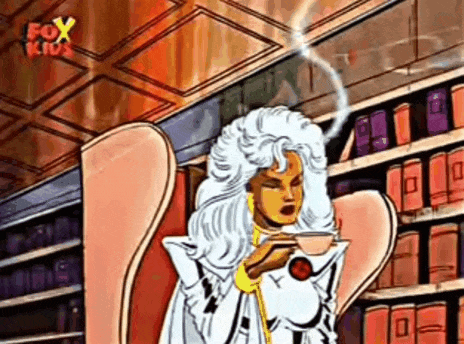
We look to Sigmund Freud’s “The Uncanny,” Jacques Lacan’s “The Mirror Stage as Formative of the Function of the I,” and Frantz Fanon’s “The Negro and Psychopathology” for our inquiry into the functions of psychoanalysis and subjectivity when examining visual texts.
Why do people call an experience or event uncanny, and what makes an occurrence that appears to be uncanny but is not uncanny?
What is the relation of personal neurosis to social passions?
In what ways are oppressed and marginalized viewers alienated when they are not or rarely represented?
@theuncannyprofessoro
16 notes
·
View notes
Text
The Glamorous Versus The Undesirable: Barbie's (2023) Addition to Our Current Landscape of Feminism
Midterm Assessment
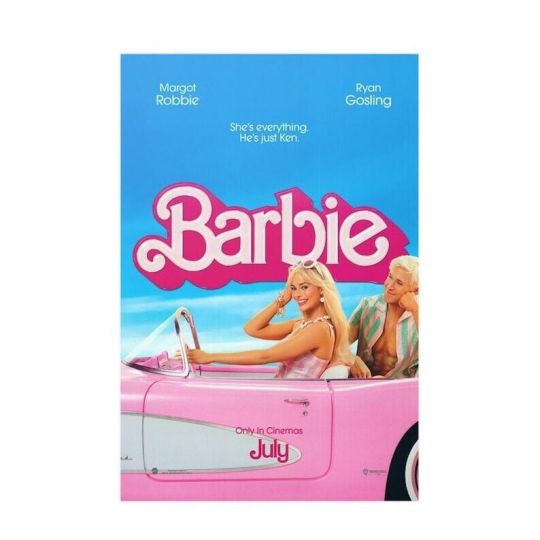
To begin analyzing Barbie (Gerwig, 2023) from a theoretical perspective, I will introduce the sources used to provide the theoretical framework for my analysis. The first text is Max Horkheimer and Theodor Adorno’s “The Culture Ideology as Mass Deception.” In this work, Horkheimer and Adorno discuss how the culture industry deceives mass audiences by providing them with art that follows a specific formula in order to maximize profit[1]. Not only that, Horkheimer and Adorno push their analysis further to state that the culture industry also enforces social conformity, which results in the individuals and the art that participate in the culture industry lacking a meaningful identity[2]. The second text is “Some Points in the Semiotics of Cinema” by Christian Metz. Throughout the text, Metz develops ideas of how semiotics apply differently to cinema than to other texts. Specifically, he discusses how connotations with respect to cinema are always specifically constructed to convey meaning to the viewer[3]. The third text is Jean Baudrillard’s “Simulacra and Simulations.” Within the text, Baudrillard expands upon the ideas of masks and repetition in poststructuralism by showing the process an image goes through to become a simulacrum. He also gives examples and explanations of simulations in real life, that seem to imitate real life but are too good to be true[4]. I believe a synthesis of these three frameworks of theoretical analysis when applied to Barbie can help us understand what the film is trying to be, and more importantly, what it actually is in our behemoth of a culture industry. Barbie is touted as a piece of prominent feminist media in many current discussions, though just as Barbie is a doll parading through a plastic world, Barbie as a film parades through our world with plastic, shallow feminism. In reality, it promotes the capitalist underpinnings of the culture industry through the signals implanted throughout the film. By simulating a reality where women are in more positions of power than men, the film provides an escape for those who do not want to face the horrors of our current reality.
Section 1: Commonalities and Overlap in Theoretical Analysis
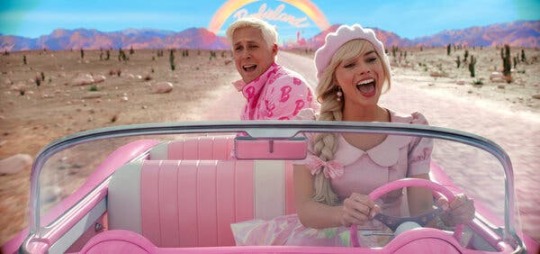
Similarities between these theorists include their analysis of our culture as it relates to our consumption of art. Horkheimer and Adorno posit that the mass consumption of art that has been specifically created for mass consumption has transformed our society into one that is incapable of creating new and innovative art[5]. Baudrillard also discusses that which is created for mass consumption; in his work, he uses Disneyland as an example of a simulation that is designed to keep participants happy and spending lots of money[6]. Metz separates this effect of mass consumption into categories of viewer and filmmaker. The viewer is the one the filmmaker creates art for, and therefore has the viewer in mind when constructing a specific shot, frame, piece of dialogue, and sequence of editing. Metz hones in on connotation, which he finds is the most important part of semiotics in cinema. The reason for this is that, as Metz describes, every moment in cinema is motivated, therefore all of cinema contains connotations rather than denotations[7]. Denotations would be moments that do not carry external meaning, which cannot happen in cinema because the audience arrives to the film armed with their knowledge of society and other films they have seen[8]. Horkheimer and Adorno would perhaps give a reason for this phenomenon being the repetition and careful curation of the art—such as films—that populate the culture industry, which doesn’t allow for much difference in representation[9]. Baudrillard would relate this constant repetition and creation of a singular narrative in the culture industry to the simulated aspect of an image[10]. By his standards, our current culture industry is a simulation in the fourth stage of an image; it no longer represents or reflects our reality accurately. Instead, it projects a simulated reality where idealized versions of ourselves live out vibrant and extravagant lives in the form of stories[11].
Section 2: Differences and Disagreements in Theoretical Analysis
Some differences that appear when putting these theorists in conversation with each other. Mainly, comparing and contrasting them show that their interpretations of our society and the art we create are not entirely aligned. Where Horkheimer and Adorno—as well as Baudrillard to a certain extent—have negative outlooks on the culture industry and the way it transforms our art, Metz mainly discusses film from an objective perspective. His analysis focuses on why we interpret cinema in the way that we do, using semiotics as a basis for this analysis[12]. Horkheimer and Adorno spend much of their work discussing the negative impacts of the culture industry, most of which can be directly tied to cinema, the Hollywood system and other related industries. They mention how the idealization of not just the characters in films but also the actors that portray them provides an aspiration for the “normal” citizens to dream for[13]. The repetitive nature of cinema, sticking to one form of storytelling and method of presentation, also prevents other interpretations from emerging in cinema. New and original art is dismissed while that which is similar to what came before is uplifted[14]. Baudrillard also uses his analysis as a way to criticize the simulations such as Disneyland that have popped up over the years. He makes a point of distinguishing that the simulated version of the image masquerading as reality is intentionally deceptive and is used to draw in consumers[15]. A critical lens is extremely important when looking at the culture industry because it is so all-encompassing. This is why Horkheimer and Adorno and Baudrillard’s analysis is so valuable. But being able to simply understand how the culture industry is able to manipulate our understanding through cinema is also valuable, which is what we take away from Metz’s work.
Section 3: Theorists in Conversation
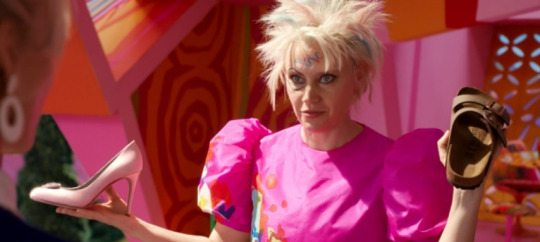
One scene in particular exemplifies the rampant materialism that Barbie promotes, as well as alluding to the surface level feminism that the film portrays as a genuine attempt at feminist critique. This scene appears early on in the film—the “refusal of the call” if we are to follow Joseph Campbell’s Hero’s Journey monomyth. In it, Kate McKinnon’s Weird Barbie presents Margot Robbie’s Stereotypical Barbie with a choice. She may stay clueless about the Real World and return to her normal life, or “learn the truth about the universe”—direct quote from the film. The “forgetting” option is represented by a pink high heel, possibly the most iconic symbol of a Barbie to ever exist, while the “learn the truth” option is represented by a worn in, brown Birkenstock sandal. This moment evokes the Matrix’s red pill or blue pill scene in what must be an intentional way from Gerwig. However, the trope of the hero choosing to “accept the call” is subverted because Barbie does not want to discover things about the Real World; she would much prefer to live her life never remembering that she had flat feet or—dear gods—cellulite. Another subversion comes with Weird Barbie’s reveal that she can’t actually forget, and it is extremely necessary for her to go on this journey of self-discovery. This moment, of course, is the catalyst for Barbie’s personal journey of self-discovery where she learns not only what it means to be a woman, but what it means to be alive.
I would like to bring this scene in conversation with the works of the theorists I have discussed thus far because I believe their work can help analyze the machinations of the materialistic culture industry that are at work in the scene. More specifically, the relationship between beauty, womanhood and humanity is something worth dissecting further.
If the pink high heel represents the path of least resistance, the one where Barbie gets to forget and return to her perfect, plastic lifestyle, then it becomes very clear that Barbie as a brand represents the idealized versions of humanity that the culture industry touts as a way to keep individuals wishing they were better, or more. Horkheimer and Adorno might chalk this scene up to the idealized versions of ourselves that we see in the culture industry through actors, artists and other celebrity figures. The choice between the heel and the sandal could be seen as a pipe dream set up by the purveyors of the culture industry, who would like individuals to believe that they have a choice in their lives, that there is a possibility that they could ascend to the levels of stardom the famous people in films and television have[16]. The lie, of course, is that the chances of that happening are one in a million. There is no choice; it is a matter of circumstance (and economic status—lots of famous people already come from pretty well-off families who can support them in their careers). With the heel representing the idealized version of ourselves that are always out of reach, the film connects Barbie with the symbol of unattainable beauty and wealth that come with the idealized position celebrities find themselves in. The Birkenstock is for the plain, the everyday, the ones that will blend in with the crowd and lead a totally normal, unglamorous life. But with the illusion of choice, Barbie presents audiences with the idea that you can choose to take the path that leads to this high beauty standard and economic privilege that comes with it. This illusion is presented to the audience in a way that makes it feel like a simulation; the product we are seeing is not what is actually there. Baudrillard posits that the simulation is meant to draw us in and keep us happily engaged in contributing to the capitalist system, whether that be spending or making money[17]. In the context of Barbie, the simulated choice between an expensive-looking high heel and a cheap, run-down looking sandal makes the viewer think that one is clearly the more high-end option that will bring them to a higher social standing, despite the fact that Birkenstocks can actually rack up pretty decent prices for a pair of shoes. However, the film rejects the idea that a choice between the two is even possible, with Weird Barbie doubling down on the fact that the “right” choice is the sandal, also known as the “normal” life option. Perhaps this is the film’s way of accepting the fact that unrealistic beauty standards and the materialistic aspects of Barbie the brand are not accessible to everyone.
Metz’s work tells us that audiences come in with preconceived notions to a film, which is why even the slightest details are worth analyzing since they can affect someone’s perception of the story. Going into Barbie, we can assume that everyone in the theater has played with, seen, or at least heard of the toy for which the film is named[18]. Therefore, the intentional association of Barbie—the brand—with a pink, plastic high heel shows how the film is intentionally connecting a symbol of womanhood with strict beauty standards and materialism. In opposition to that is the Birkenstock sandal, which is an ugly brown color and seems to be quite well worn. Opposing a more laid back lifestyle through a shoe that is associated with a lower beauty standard with the classic shoe style worn by beautiful women—one of whom being Barbie—also opposes a (non-gender specific) human lifestyle with that of womanhood. The signs are there: heel or Birkenstock. The underlying connotation would be that women will have to choose between conforming to a strict beauty standard (one that is partially set by brands like Barbie) and living their lives more freely but having to sacrifice their femininity to do so. Also, not taking a pluralistic approach to femininity severely damages the feminist dialogue the film is trying to create. I think a more shallow reading of this scene—just looking at the interpretation of the two shoes there are to choose from—could be saying that there is no one way to live as a woman. However, the fact that Barbie immediately wants to choose to “forget” and go back to a perfect lifestyle puts that performance of femininity on a pedestal, something to reach for but never truly attainable—unless, of course, you are Barbie.
Conclusion: Synthesis

To conclude, the theoretical works discussed in this analysis provide much-needed insight on the underpinnings of the culture industry that are masquerading within Barbie. Though the film may contain feminist messaging and truly does a good job at introducing new feminists to this type of thinking and language, the film does not live up to the hype it was getting as a great new piece of feminist media. Mainly these problems come from the idealization of capitalism and materialism through the brand of Barbie itself, which encourages material spending and sets a beauty standard that is basically unreachable for most women, limiting the kind of beauty to a specific expression of femininity. Barbie also simulates a choice for viewers that further encourages the idealization of celebrity figures, though in reality the choice is a matter of circumstance. Though it claims to be a piece of feminist literature for mass audiences, Barbie ends up as feminism for—and by—the ruling class.
[1] Horkheimer and Adorno
[2] Horkheimer and Adorno
[3] Metz
[4] Baudrillard
[5] Horkheimer and Adorno
[6] Baudrillard
[7] Metz
[8] Metz
[9] Horkheimer and Adorno
[10] Baudrillard
[11] Baudrillard
[12] Metz
[13] Horkheimer and Adorno
[14] Horkheimer and Adorno
[15] Baudrillard
[16] Horkheimer and Adorno
[17] Baurdrillard
[18] Metz
@theuncannyprofessoro
0 notes
Text
Analytical Application 3
Generality:

Generality can be partially defined by being the opposite of repetition. That is, it is both the “qualitative order of resemblances” and the “quantitative order of equivalences.”[1] Where repetition injects a creative twist to its variations, generality mandates that things are placed into similar categories such that they can be universally defined by the same label. In Run, Lola, Run, generality can be found in certain scenes where photographs are used to examine the futures of those that interact with the protagonist, Lola. Several characters experience this over the course of the film, but for analytical purposes we will look at the young male character with the bike. His first iteration of photographs displays him getting mugged, finding a girl when he goes to get patched up, then his marriage to said girl (Tykwer, 1998, 15:56-16:03). Though these photographs portray the character’s individual experience, the fact that it is shown in the film clues the viewer in to the fictionality of the story, and therefore they are able to identify the tropes displayed through short synopsis of the character’s life events. A trope is a manifestation of generality, as tropes are repeated and reused in stories worldwide. They are so recognizable in concept that small elements are able to change within them, yet they can still be lumped into the same category. A ‘miscommunication’ trope is still miscommunication whether the characters think the other cheated or is on the brink of death. Small changes still evoke the general recognition of the trope in the viewer. Though creativity in repeating these tropes can breath new life into them, the short snapshots of the character’s future rely on recognizable ‘plot points’ within these tropes so that the viewer can pick up the story in only five or six photographs. Therefore, the repetition points more towards resemblance than repetition.
Postmodern:

The postmodern is a “negation of the previous epoch,” which in this case is modernism.[2] Jameson also asserts that postmodernism aims to appeal to the masses, which opposes the individual expression of the modernist era.[3] In order to achieve both of these ideals, postmodernism draws on nostalgia and the pastiche to create recognizable images that the audience will love upon first sight. In Run, Lola, Run, this postmodern effect comes in the form of the scene bathed in red post Manni’s death. This scene is a repetition of the one from when Lola herself died. The main characters are lying next to each other in bed, washed in red lighting, smoking and pondering love and death (Tykwer, 1998, 52:29-54:40). Because this scene comes later in the movie, after we have already seen its predecessor, the audience is able to recognize the scene right away from its coloring and the framing of the actors. Even though the audience saw the other version only twenty minutes prior, there is already a sort of nostalgia for it, a longing to go back to the past. Since this scene comes after the death of Manni, the audience has only to wonder if Lola will be able to save both of them the third time around. The scene has a postmodern feel to it because of this nostalgic appeal as well as its immediate recognizability to those who have seen the prior scene in the movie that is similar to it.
Repetition:
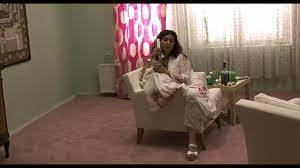
Repetition, as described by Deleuze, is a “transgression.”[4] It functions by creatively putting out variations, which favors an artistic reality rather than that which follows the natural law. Repetition does not belong with generality, though Deleuze does admit that repetition may be appropriate when you cannot replace something with that of equal value (a resemblance). In Run, Lola, Run, the first major repetition is exemplified when Lola seemingly travels back in time and relives the past twenty minutes again (Tykwer, 1998, 34:26-35:42). During the repetition, some things stay the same, such as Lola’s mom asking her to buy shampoo (funnily enough, this never changes during any of the repetitions during the film) and Lola running down the stairs. The first ripple of creativity that this repetition utilizes is when Lola runs past the guy with the dog. Unlike the first iteration where she just runs past them both, the guy trips Lola so she falls down the stairs. Though it is a cruel moment, it shows the audience that this time, things are going to be different, which not only keeps them engaged, but furthers the idea that repetitions are favored in an artistic reality.
Simulation:
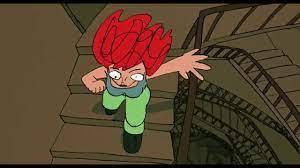
A simulation is formed at the fourth phase of an image. Baudrillard explains the phases of the image as such: it reflects reality; it masks or perverts reality; it masks the absence of reality; it no longer relates to reality.[5] By the fourth phase, the image is its own simulacrum, or part of a simulation. The simulation aims to conjure up the idea of reality without really being there. It tries to deter those within the simulation from ever comparing it to reality and trying to leave it. When Baudrillard compares Disneyland to a simulation, he is not far off; the theme park tries to create an imaginary reality so enticing you’ll forget that you have to leave.[6] In Run, Lola, Run, there is a scene where the camera pans from Lola to her mother in a separate room, then to an animated version of Lola running down the stairs (that plays on the TV in her mother’s room), then cutting abruptly back to reality when Lola opens the door (Tykwer, 1998, 11:45-12:40). The animated section can be designated as the simulation and the live action part as the reality. The animated section as the simulation works as it feels like a world within a world, as Lola running downstairs plays on the TV while also definitely happening in real life. The blending of these two, making them inextricably linked, forges a bond between the simulation and the reality that makes it hard to separate them. The animated world might seem more ideal since there seem to be less repercussions than in the real world. The interesting part about this simulation is that it does, in fact, relate to reality. The audience assumes that because animated-Lola is running down the stairs, real-Lola is too. By linking the animated world to the real world—the simulation to the reality—the director is able to streamline the storytelling.
Pastiche:
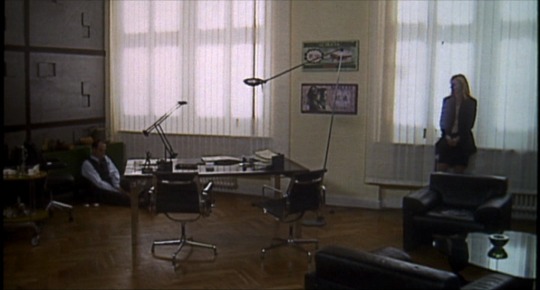
Jameson defines pastiche as such: “parody without the humor.”[7] Where a parody uses satirical devices to repeat and retell, a pastiche imitates the original work, using its style to create something new. Though a pastiche may be created in good faith, it often does not add anything to the original work. Paying homage to the original work is all well and good, but it is only a reproduction of an artwork that has already been tried and tested. This new work has nothing to say about the old one other than that it was inspirational. There is such a scene in Run, Lola, Run. Before Lola enters her father’s office, there is a short scene where her father speaks with the woman from the board of directors. It is all very dramatic; she tells him she’s pregnant, he says he’ll leave his wife for her, all that jazz. The scene, notably, is heavily filtered to have this old TV grain effect. It conjures up images of dramatic soap operas and TV shows where the protagonists are in love but can’t be, where they must go against all odds to be with each other. The grain is a nice shortcut to get the audience invested in that subplot quickly just by mere association, but the interesting part is when Lola enters, this grain immediately vanishes. Clearly, the grain is only meant for when those two characters are together talking about their love. This is a pastiche, an imitation of the old without bringing saying anything about it. Even in the consequent repetitions of the scene later in the film, the grain remains while the story fluctuates through different dramatic beats of a TV soap opera. The pastiche takes the remake of this drama seriously, without even a drop of humor to identify it as a parody. This choice makes it easier for the audience to get invested in the story of these characters, but the grain going away when Lola enters clues the viewer back in to the real story.
[1] Deleuze
[2] Jameson
[3] Jameson
[4] Deleuze
[5] Baudrillard
[6] Baudrillard
[7] Jameson
@theuncannyprofessoro
0 notes
Text
To break down an image, according to Baudrillard, there are four phases. The first is the image is a reflection of reality. The second is that it masks or perverts basic reality. Then the image masks the absence of a basic reality, and finally the image doesn't relate to reality at all. By the end of the four phases, the image has become its own simulacrum. Essentially the four phases can be summed up as such: good, evil, pretend, then simulation. Baudrillard also says that when reality no longer reflects itself, nostalgia is able to take over. Myths, second-hand truths and and lack of objectivity are a part of this simulacrum. These four phases help to further the belief that the real is happening within the simulation (Baudrillard).
Parody, as Jameson says, makes a mockery of the subject it discusses by injecting satirical and comical undertones in its replication of the original. But when the parody goes too far it becomes the pastiche, a repetition and replication of the original work in the style with absolutely no humorous undertones. The pastiche is where the "death of the subject" occurs (Jameson); there becomes a point where the subject has been masked and rewritten so much that the intent behind that act has become distilled into a meaningless endeavor.
@theuncannyprofessoro
Reading Notes 5: Baudrillard to Jameson
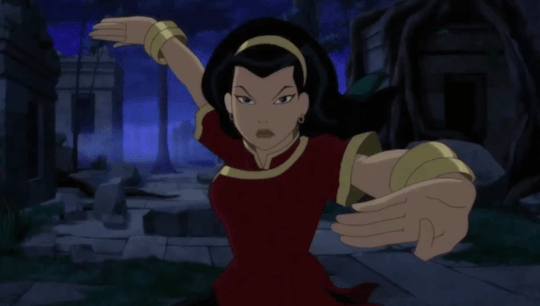
To further our studies in visual analysis, Jean Baudrillard’s “Simulacra and Simulations” and Fredric Jameson’s “Postmodernism and Consumer Society” offer guidance to understanding the roles of poststructuralism and postmodernism.
What are the four successive phases that break down an image?
What is the relationship of parody to the object it mocks, and at what point does parody become impossible and pastiche appear?
@theuncannyprofessoro
16 notes
·
View notes
Text
To the last question, I'm not sure that an aura with respect to film can necessarily be depleted. The audience is the one who receives the image, yet because of editing, they will never know if a shot has been redone or replicated. Because audience perception is such a big part of the film industry, I think aura comes from the feelings the audience will associate with the images, not the authenticity of the film with respect to replication.
Discussion Leader Panel Presentations
Pink Floyd: Nothing but the Machine

Young students run around causing a ruckus, complaining about their evil teacher who traps them with the masses. Being a hundred times the size of the students who are ants in comparison, the teacher has an easy time putting the kids into the roof of a standard British home that appears to be a funnel and are turned into spaghetti as he watches through his glasses where one lens enlarges into a magnifying glass. The students' lack of individuality reigns supreme in Pink Floyd’s, “Another Brick in the Wall, Part Two,” they are just another noodle. In “The Ruling Class and The Ruling Ideas,” Karl Marx and Friedrich Engels make the point that the ruling class, the teachers, control the means of material and mental labor, which is divided for one half to appear as thinkers while the other stays passive and grounded in reality. This allows for one class to rule all just like a teacher runs a classroom in 1970s England (Pg. 59-60). Marx and Engels discuss how ideas are not independent of politics, just as music and art are intertwined with politics. Pink Floyd were one of the most influential bands to criticize the education system and how teachers back then put kids in a box as seen in the imagery of a white brick wall encasing a student sitting on the dirt ground. In “Ideology and Ideological State Apparatuses,” Louis Althusser writes:
“School (but also other State institutions like the Church, or other apparatuses like the Army) teaches ‘knowhow’, but in forms which ensure subjection to the ruling ideology or the mastery of its ‘practice’. ‘professionals of ideology’ (Marx), – the tasks of the exploited (the proletarians), of the exploiters (the capitalists), of the exploiters’ auxiliaries (the managers), or of the high priests of the ruling ideology (its ‘functionaries’), etc” (Pg.88).

Pink Floyd paints a picture of the ruling class quite literally trapping a child inside a brick wall by the high priest Althusser speaks of, the teacher. Keeping the youth trapped without hope of living their dreams only will force them into the wall of never contradicting their superiors and never accomplishing anything. Instead, the children will end up in the workforce where they will be miserable.

The sad reality is presented in the shot of silver hammers with red and black handles marching like the military in a dark and cloudy night. Each hammer represents a different child who the high priests trapped into our established system, even if that means the children are unhappy because they grew up to work meaningless jobs. Pink Floyd, Marx, Engels and Althusser all agree that the system's hierarchy is oppressive as the ruling class subjects everyone else into a working majority that builds the infrastructure that keeps the upper class afloat and in power. It's a cycle where the high priests manipulate the children to be the same as everyone else so they stay and grow up to work the same jobs as their parents just like their own kids will.
Thom Yorke and the Aura of Surrealism
Thom Yorke from Radiohead and The Smile made a solo album titled “Anima” and a short film with Paul Thomas Anderson of the same title to go along with it. The film features the songs, “Not the News,” “Traffic” and “Dawn Chorus.” In Walter Benjamin's essay, "The Work of Art in the Age of Mechanical Reproduction," he discussed mechanical reproduction and how it depleted the uniqueness of works of art, writing “even the most perfect reproduction of a work of art is lacking in one element: its presence in time and space, its unique existence at the place where it happens to be” (Pg. 667). Thom Yorke is one of the few modern musicians who proves Benjamin's critique of artistic authenticity wrong. “Anima” exists outside of time and space. Benjamin’s comments on retakes in film and music is that it depletes the aura of the piece. Maybe multiple takes does make a work of art less organic, but Paul Thomas Anderson’s direction appears natural in its own right as the film begins with a location all too familiar for many people, the train.

To perfect something, or rather to record something numerous times can only benefit the artwork at hand, but that's just my opinion. Benjamin does speak on the meaning of aura relating to authenticity and Yorke and Anderson show the inside of a subway where everyone is wearing the same coat and flips it over with a choreographed dance sequence of each person moving their body in a bizarre lifeless way. Yorke and Anderson make their point that authenticity and surrealism can go hand and hand.

After the dance sequence, Thom Yorke picks up a woman's briefcase and proceeds to exit the train to give it back to her. Instead, he loses her and wanders around in a dream-like dystopian world. He is searching for answers but nothing is received. There's a point where he tries to exit the station but the turnstile won't move. The same people in identical trench coats continue to walk through the turnstile right next to him, but his still won't budge. The audience is left to ponder the question of what it meant. This is exactly what I want out of art, displaying an ambiguous critique of society. Art becomes repetitive when the answers are given to the viewer instead of the filmmakers forcing the audience to think critically about the film and its meaning. Thom Yorke and Paul Thomas Anderson let the viewer experience a dream-like state so they can apply it to an everyday event such as taking the train to work. Yorke and Anderson are breaking the laws of time and space in the film with surreal imaginary and bizarre and striking choreography. “Anima” created its own aura that is not aligned with the idea that a piece needs to be viewed in a specific way or the authenticity will be lost. The authenticity of “Anima” is its unique and uncanny perspective on reality. Maybe Walter Benjamin wouldn’t mind retakes if films were as inventive as “Anima.”
Critical Thinking Questions
According to Marx and Engels, ideas are not independent from politics. Do you think art and politics should be grouped together or can the two be separate?
Is Pink Floyd’s “Another Brick in the Wall, Part Two” overly cynical towards capitalism that's perpetuated by what Althusser describes as “high priests,” or is it justified?
Do you agree with Walter Benjamin's opinion that retakes deplete the aura of films?
Marx, Karl. Marx and Engels Collected Works Volume 5: Marx and Engels 1845-47. Lawrence & Wishart Limited, 1976.
Sharma, Aradhana, and Akhil Gupta. The anthropology of the state: A reader. Oxford, UK: Blackwell Publishing, 2006.
Braudy, Leo, and Marshall Cohen. Film theory and criticism: Introductory readings. New York: Oxford University Press, 2009.
6 notes
·
View notes
Text
The last discussion question for Radio Ga Ga made me think of the growth the dystopia genre has undergone even within the last two decades. Queen's perception of a dystopia has to do with the mass distribution of technology and information that is in direct conflict with humanity (hence the usage of Metropolis footage). However, after the likes of the Matrix the dystopia, especially the YA dystopia, has catapulted our perception of dystopia to a conflict between different ideologies (or even natural crises) that humans have to deal with--technology is a set piece in these stories, except for social media.
Levi Stine - Ideology and Culturalism II
“Bitch Better Have My Money”
youtube

Rihanna’s Bitch Better Have My Money, first and foremost, puts money at the center of human motivation. The entire concept of the video’s narrative is for Rihanna’s protagonist to obtain the money owed to her. Observing this work through the eyes of Horkheimer and Adorno, it is clear that this perpetuates the idolization of money in the culture industry. “Their ideology is business”,(1) and the ideology of this video drives the business of both the music industry and the culture industry. Horkheimer and Adorno claim that “the only escape from the work process is adaptation to it in leisure time.”(2) Viewers of this video consume a barrage of capitalistic ideals, most poignantly the way in which the kidnappers live in luxury because of their dirty, violent work. Much of the video takes place on their yacht (2:48-3:28), a testament to their wealth. The culture industry also seems to be represented by Rihanna herself. She is an unstoppable force that has come to take what’s hers, parallel to the irresistibility of the culture industry and how no one can survive without being roped into it.(3) Horkheimer and Adorno also claim that the media of the culture industry creates an illusion that is believed to still be connected to the real world,(4) and the normalization of such violence in the video can have a negative effect on viewers. Rihanna and her team of kidnappers perpetuate Horkheimer and Adorno’s notion of the all-consuming culture industry, an industry that worships money and the hard labor falsely-cited as required in order to obtain it.

Signs are in effect all throughout Bitch Better Have My Money, and are often subverted throughout the narrative. Stuart Hall states how denotation is controlled by the sign sender, while connotation, the reception of the message by the individual, is subject to numerous external factors. (5) The video opens (0:08-0:20) with a woman's legs sticking out of a wooden chest. Then, a woman is introduced in a lavish home with a formal dress and shiny earrings (0:21-0:31), denoting wealth while connoting, within the context of the story, money that has been immorally-obtained. As the narrative of the story progresses and the rich woman remains held hostage, the viewer assumes that she is the one who will end up in the chest, that she is the “bitch” who “better have my money.” The video twists this on its head with the introduction of Mads Mikkelsen’s “The Accountant” (5:21), as well as the backstory of the situation, switching the connotation of Rihanna’s actions from seeming like senseless torture to being perceived as a powerful resistance against an evil man who wronged her. Hall claims that the process of encoding and decoding requires a means and a relation for social production, (6) a context for the sign to be put in. BBHMM, a hit song by a woman in an industry historically dominated by men, mirrors the female empowerment that the video displays in the climax of the narrative. The final shot of the video reveals Rihanna herself as the woman in the chest (6:02-6:37). She’s naked, smoking a cigarette, and covered in money and blood. The visual denotes the mutilation of The Accountant and a rightful repossession of funds. More intuitively, the phallic imagery of the cigarette in her mouth and her nudity, as well as the nudity present throughout the video, connotes a sort of sexual power and domination to the narrative. When the topless hostage signified vulnerability, while the final shot provides Rihanna with an upfront strength and badassery.
Discussion Questions:
How do you think the culture industry’s perspective on money would change if creation within the industry itself wasn’t so lucrative?
In what ways would Rihanna change the signs in her video if she wanted to portray herself as the antagonist, and the hostages as the protagonists?
“Radio Ga Ga”
youtube
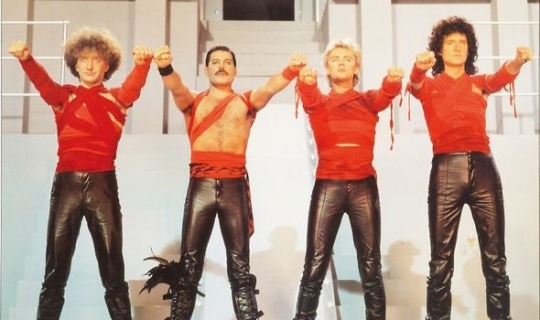
Queen’s music video for their 1984 hit “Radio Ga Ga” details the inner workings of the culture industry in true dystopian fashion, exaggerating the role of technology in our lives in order to reflect on how we use it. Horkheimer and Adorno believe that “culture today is infecting everything with sameness.” (7) Queen exemplifies this fear in a sequence that occurs during the first and second chorus (2:12-2:38 and 3:37-4:01), in which the four band members, dressed in red, rally a mass of people, dressed all in white. Queen extends a salute and the crowd echoes it. This sequence represents a society ruled by radio (“All we hear is/Radio ga ga”), conforming and oppressive. This is a scenario in which “ideology becomes the emphatic and systematic proclamation of what is,” (8) causing nothing new or creative to emerge from this fictional modern-day society. The video puts radio at the root of the future’s problems, but at the same time, radio is praised for having been so simple. The concept of a music video being nostalgic about a time in which only radio existed is a contradictory example of Horkheimer’s and Adorno’s belief that within the culture industry, the message of a work emerges from the same school of thought as the lens through which people receive it. (9) Music lovers will watch this video and further praise a technology that innovated music listening (this connection only strengthens as time goes on and nostalgia for the music video itself increases).
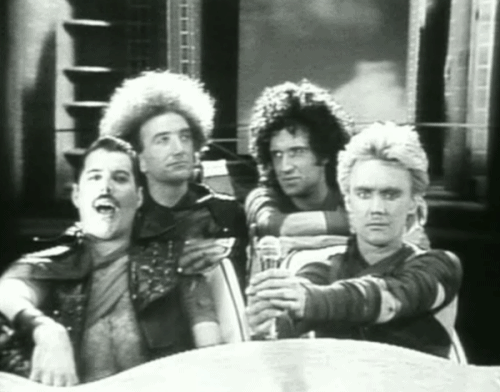
The “Radio Gaga” music video effectively uses visual signs to convey their anti-dystopian message. Hall cites Barthes’ notion that the connotation of the signifiers given to audiences is closely linked to the audience’s culture. (10) In the 1980s, music videos were incredibly popular, and they were an example of the many technological advancements brought on by the decade. The futurism of this video’s world, at the time of the video’s release, may have been met with celebration and excitement, while in the “postmodern” age we live in now, the video is understood to be a warning against technological domination. This video may now serve as an example of how the connotation of an encoded message can be changed over time. Further details within the video act as signs, outlining their process and function in digital media. As previously mentioned, the image of the band in red rallying and controlling the masses in white (2:12-2:38 and 3:37-4:01) connotes government/state control, as those colors are reminiscent of many harsh dictatorships throughout history. The use of clips from the german film Metropolis (1927) in the beginning of the video (0:00-0:31) shows a parallel between this video’s message and the fear of technological dystopia that is present in other important forms of media in other countries. As someone previously familiar with the film, I assumed what Hall defines as a “negotiated code” when I viewed the video, in that I understood what had been “dominantly defined” because the video presented situations and events which were “in dominance”, that I understood. (11)


Discussion Questions:
What are some other ways in which technological advancement has increased the scope of the culture industry?
How do you think that the globalization of information has contributed to the reception of media through “negotiated code”? What sort of dystopia would Queen be fearing if they created this video today?
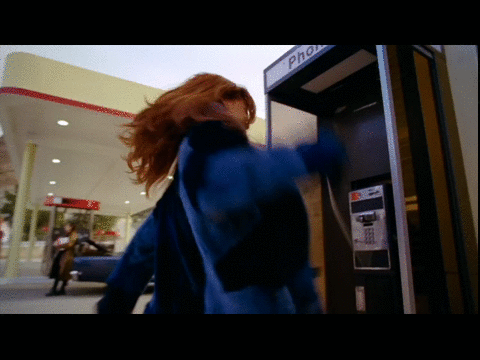
1 Max Horkheimer and Theodor Adorno, “The Culture Industry: Enlightenment as Mass Deception,” in Dialectic of Enlightenment (California: Stanford University press, 2002), 109
2 Horkheimer and Adorno, The Culture Industry, 109
3 Horkheimer and Adorno, The Culture Industry, 104
4 Horkheimer and Adorno, The Culture Industry, 99
5 Stuart Hall, “Encoding, Decoding,” in The Cultural Studies Reader (London: Routledge, 1993), 513
6 Hall, Encoding, Decoding, 508
7 Horkheimer and Adorno, The Culture Industry, 94
8 Horkheimer and Adorno, The Culture Industry, 118
9 Horkheimer and Adorno, The Culture Industry, 102
10 Hall, Encoding, Decoding, 513
11 Hall, Encoding, Decoding, 516
@theuncannyprofessoro
8 notes
·
View notes
Text
Thinking about the first discussion question, I see the commodification of art as something that happens in lower levels of socio-economic class. If we think about "high art" like super expensive pieces at the Louvre or like the opera or the ballet, those types of art seem less commodified because they have more prestige to them, versus things like film and other types of art that are mass produced for a wide audience. In this sense, maybe accessibility is a qualifier for commodification?
Ideology and Culturalism II: Pop Icons!

youtube
Rihanna’s music video for “Bitch Better Have My Money” reflects the inner workings of the culture industry through the ideology discussed within the workings of Adorno and Horkheimer. Firstly, to give a general overview of the music video and its role within the culture industry, Rihanna glorifies themes of wealth, power, and materialism–contributing to the ideas of commodification and dependency on economic value. The video begins with kidnapping the wife of a “wealthy” man, as the video progresses, we see Rihanna partaking in luxuries and borderline opulent activities while keeping the woman hostage. Money is at the very center of the music video, from driving a convertible (01:59-01:57), lounging on a yacht (02:48-03-27), to partaking in the usage of drugs and alcohol (03:58-04-26). Adorno and Horkheimer reveal the manipulations within the culture industry–the falsification of profitable “needs.” Adorno and Horkheimer argued that the culture industry manipulates individuals' desires and preferences, the music video profits off the societal desires for success through wealth indicators–reinforcing materialism under a capitalist framework.
This is an industry that idealizes consumerablity to value and gauge the necessity of a product which disturbs the artistic process of creation. All forms of art, from podcast to music video, are subject to the interests of money. While this prioritization of money is explicitly promoted in the lyrics of BBHMM, the song fits the standard mold of creation. There is a repetitive nature within the lyrics, art is then removed from the artist–it becomes a commodified product, transformed and designed for profit. The industry is solely concerned with making profits–this is directly linked to pop culture and everything in between.
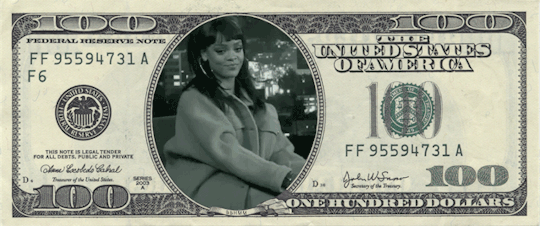
Rihanna, herself, is a pop culture icon that is subject to the means of a mass capitalist consumerist mindset displaced within the music industry. She reflects the timely trends of the time, we can see this through the musical style of the backing track and the stylized outfits from 8 years ago. Down to the makeup trends of a long and thick liner and the neutral but bold lip color, implementing the micro trends of 2015 to mold to what would reel in the masses. The standardized content to capture the interest of the masses to form to contribute to a homogeneous culture of values.
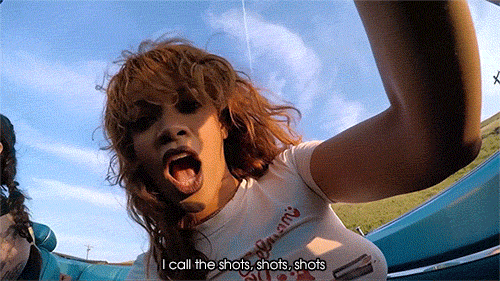
During the process of encoding and decoding, the viewing audience may have varying interpretations of the music video based on their personal experience and background. Some may see the video as a form for women empowerment, the breakdown a male-dominate industry. Rihanna taking control and asserting herself as a force to be reckoned with. Or, others can see this as the glorification of violence as a means of retaining wealth and power. This ties into the commodified rebellion aspect of the culture industry. We as an audience interpret and decode Rihanna as a powerful figure, empowering women for the sake of feminism, but at the same time she is primarily making profit from our sentiment, rather than directly advocating for women.
youtube
"Bitch I’m Madonna", coming out the same year as BBHMM, functions in a similar manner to Rihanna’s work. Both pop star icons, which directly support Adorno and Horkheimer’s beliefs on the culture industry, have been molded into marketable products for mass consumption by the culture industry. The name “Madonna” has become a brand itself, which is apparent in the name of the song! Her image is enhanced through her commercial appeal as a global and legendary celebrity. She also incorporates cameos from different house-hold name celebrities (02:00-02:28) like Beyonce, Kanye, Katy Perry, and Miley Cyrus–highlighting the interconnectedness of fame and strengthening the celebrity culture. Keeping it in the circle, literally, supports the capitalist notions of social status, a notion that Adorno and Horkheimer challenge in their work.
Based on the way the music video was filmed, Madonna features an excess of wealth and luxury through a party-like concept, and is constantly surrounded by glamorous clothing and accessories. By barely having any cuts, almost a one shot, and Madonna as the focal point, the music video carefully crafts a branded image where success is measured by the individual’s own ability to make a name for themselves–promoting a culture of consumption. The flashy visuals, bright colors, and the strong and visually appealing choreography conforms to the ideas found within the culture industry and its expectations of a formulaic, mainstream media piece.

Madonna received a lot of negative criticisms and feedback when premiering her music video back in 2015. The public reception consisted of a lot of people suggesting that Madonna was clawing to stay “relevant” at this time by displaying acts that are typically done by younger folk. Tying this to Stuart Hall’s findings of encoding and decoding, a viewer may receive a message of excessive narcissism within the world of Madonna. In correspondence to Hall’s ideas on oppositional reading, Madonna encodes the music video with her vibrancy and energy, showcasing empowerment for an older generation, but through decoding the message, one might suggest that the focus on materialism is detrimental to the career of the icon. The dynamic nature of decoding supports Stuart Hall's theory, emphasizing the active role of the audience in making meaning from media texts.
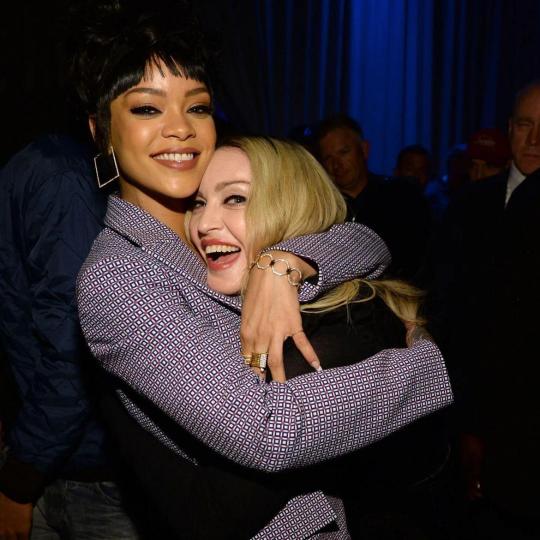
Both iconic women showcase their adaptation to cultural trends of the era in media; due to both celebrities being subject to the culture industry, the use of conformity is a characteristic of the mass production of cultural products–this is also applied to the standardized format commonly found in the music industry that can diminish the artistic integrity found in the careers of both Rihanna and Madonna. Through the use of iconography, an audience may decode both artists’ expressions in the context of social frameworks.
Based on the conceptualization of the culture industry, are there aspects of pop culture that do not fall under the commodification of art?
How does the interplay between the sound and visuals of both Madonna’s “Bitch I’m Madonna” and Rihanna’s “Bitch Better Have My Money” challenge or support each other? How may that influence the process of decoding the messages from the artist?
In what ways is Madonna and Rihanna presented as a marketable commodity in her music videos from now and before, and how does this reflect the commercialization of art discussed by Adorno and Horkheimer’s “The Culture Industry as Mass Deception?
Max Horkheimer and Theodor Adorno, “The Culture Industry: Enlightenment as Mass Deception,” in Dialectic of Enlightenment (California: Stanford University press, 2002)
Stuart Hall, “Encoding, Decoding,” in The Cultural Studies Reader (London: Routledge, 1993)
13 notes
·
View notes
Text
To answer the second discussion question, I think some of the similarities can be drawn between the music video through the signs they present. It's really interesting that they're both love stories about chasing after the person you love to the point that you enter into a completely different world. Some of the signs presented like tropes and characters that make the audience think of love are present in both videos, and I think that's why the vibe is sort of similar between the two.
Structuralism and Semiotics
youtube
The music video for a-ha's "Take On Me" was released in 1985 and and utilized a groundbreaking blend of live-action and animation, specifically rotoscoping. The video's most striking feature is its unique visual style. It begins with a live-action sequence, set in a cafe where the use of lighting and cinematography sets a nostalgic and somewhat romantic tone.The most memorable aspect of the video especially during this time is its use of rotoscoping animation. This technique involves tracing over live-action footage frame by frame to create a stylized animated look. The animation transports the protagonist, into a comic book world filled with action and adventure. The video tells a narrative of a young woman, who becomes absorbed into a comic book and embarks on a thrilling adventure with the protagonist. It's the classic boy meets girl story but with a twist. The comic book setting symbolizes the power of storytelling and the ability to create one's own narrative. The video for had a significant impact on popular culture and set a new standard for music videos. Its innovative use of animation inspired countless artists and filmmakers, and it remains a beloved and frequently referenced cultural touchstone decades after its release.
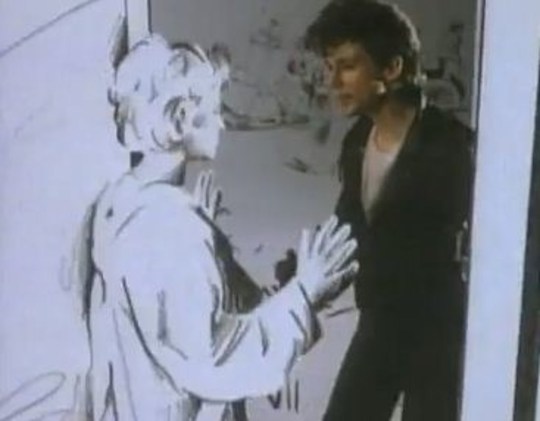
Taking a deeper analysis into the video Saussurean concepts of sign, signifier, and signified are present. In the music video, various signs are presented visually (such as characters, settings, and actions) alongside the auditory signifiers: the music and lyrics. The sketches shown throughout the video represent a signifier that conveys the concept of the protagonist imagined world or desires (signified). Analyzing this through Metz’s lens, the signifier of the animated characters entering the comic book world signifies a journey into fantasy or escapism. Escapism is a present theme in this video as it follows a narrative arc in which the protagonist transitions between the real world and the animated world representing the transition between reality and fantasy, echoing the themes of the song itself. The theme of escapism is also represented through the paradigmatic relation that is created with the contrast between the real-world setting and the animated world. Syntagmatic relations is also present in this video as the sequence of visual and auditory elements creates a syntagmatic structure.The progression of scenes, transitions, and actions forms a narrative sequence that guides the viewer through the story depicted in the video.

Analyzing through the lens of Roland Barthes the video might be perceived as selling the idea of transcending reality through love and imagination, much like how detergent ads sell the idea of transcending dirt to achieve cleanliness. In the video the animated world serves as a guide to a fantastical realm, inviting viewers to explore new possibilities and perspectives while guiding them through a journey of romance and adventure which can be connected to Barthes discussion on the cultural significance of travel guides. Barthes discusses the manipulation of historical narratives in films to convey certain ideologies which can be seen in the music video as it presents a narrative reminiscent of a romance or adventure film. The transformation of entering the comic book world can be seen as a modern interpretation of historical narratives, where the past is reimagined and romanticized for contemporary audiences. The romantic relationship depicted in the video can be interpreted as emblematic of idealized love or romanticized partnerships, reflecting societal norms and expectations surrounding relationships. Barthes discusses how modern myths are constructed and perpetuated through various forms of media and the music video constructs a myth around love, adventure, and escapism. The video perpetuates these myths through its visuals and narrative, reinforcing cultural ideals and values associated with romance and fantasy. In conclusion, analyzing the music video through different lenses reveals how the video constructs and perpetuates cultural myths surrounding love, adventure, and escapism. These lenses help us delve into the videos semiotic dimensions, exploring how the use of narrative, imagery, symbolism, signs and signifiers serves to create meaning within the visual and auditory text and reinforce societal norms.
youtube
The music video for "Nothing's Gonna Stop Us Now" by Starship was released in 1987 and played a significant role in the song's success. The video primarily takes place in a movie studio, reflecting the theme of the song being featured in the film “Mannequin.” This setting allows for various backdrops and sets to be utilized, adding visual interest and diversity to the video. The video follows a narrative that intertwines scenes from the movie “Mannequin” with footage of the band performing the song. The storyline of the movie, which revolves around a mannequin that comes to life, complements the message of the song about love overcoming obstacles. Throughout the video, shots of the band performing the song are interspersed with the narrative scenes. The band members are shown singing and playing their instruments with energy and enthusiasm, adding to the overall excitement of the video. The video includes romantic scenes between the characters from the movie, emphasizing the theme of love and connection. These scenes enhance the emotional impact of the song and reinforce its message of resilience and devotion. The video incorporates various visual effects, including transitions between scenes, lighting effects, and overlays, to enhance the overall aesthetic appeal. These effects contribute to the video's polished and professional look, aligning with the high production values of the song and its accompanying movie. The video features dynamic camera work and creative framing, capturing the energy of the band's performance and the emotional moments of the storyline.
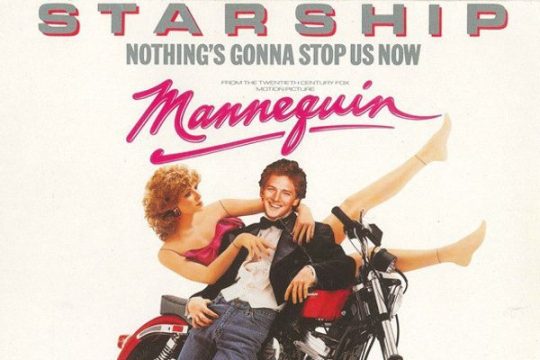
Analyzing the music video through the lens of Roland Barthes' essays from “Mythologies” offers an opportunity to deconstruct the cultural symbols and myths embedded within both the song and its visual representation. Barthes discussion of the manipulation of historical narratives to convey certain ideologies which can be seen in the video through elements such as the portrayal of the band members and use of dramatic backdrops that convey a sense of epic scale and evoke grandeur, triumph, and romance reminiscent of classical narratives. In the music video, themes of cleanliness, purity, and renewal, are symbolized through imagery such as bright, pristine settings, or the use of light and color to convey a sense of freshness and vitality. In the music video, their are references to travel and exploration, as the protagonists embark on a journey together against various scenic backdrops. These settings could serve as symbolic landscapes representing the adventure and possibilities inherent in love and partnership. The intimate moments portrayed between the protagonists represent domestic bliss and reinforce the narrative of enduring love and commitment which connects to Barthes values of stability, responsibility, and domesticity.

Metz discusses how cinema uses various codes and signs to convey meaning which is shown in the video as there are several codes such as visual imagery, music, lyrics, and performance. These codes work together to create a narrative and evoke emotions. The video follows a narrative structure that complements the song's lyrics. Based on the title and lyrics of the song it could be depicting a story of love, perseverance, or triumph over obstacles. The video utilizes cinematic techniques such as camera angles, editing, lighting, and choreography to convey its message. An example of this is the close-up shots that are used to emphasize emotions, while fast editing may create a sense of energy and excitement. Applying Metz's framework to the video allows for a deeper understanding of how its various elements work together to create meaning and evoke emotions in the viewer. In the video the facial expressions and body language of the performers, as well as the imagery used in the video to represent themes of love, determination, and overcoming obstacles. Saussure's theory of binary oppositions suggests that meaning is often constructed through the contrast between opposing concepts. Instances of binary oppositions are shown in the music video, such as contrasts in lighting, color palette, or visual motifs, which contribute to the overall message of the song. This lens gives us insights into how visual signs and symbols are used to convey meaning, emotion, and narrative in the context of popular culture and media production.

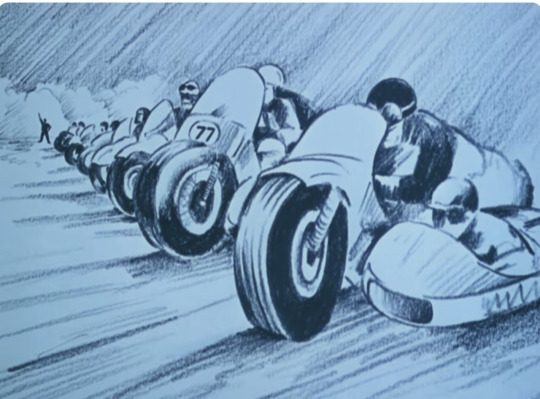
Discussion Questions:
Are there instances where the visuals seem to contradict the lyrical content?
What similarities can be drawn from both of these music videos? What about the actual songs? Is there any differences?
Do you think that the music videos represent the music correctly?
Why do you think love is portrayed the way it is in these music videos?
Do you think that semiotics were a present part when these videos were made?
Ferdinand de Saussure, Course in General Linguistics, trans. Wade Baskin (New York: McGraw-Hill Book Company, 1915)
Roland Barthes, Mythologies, trans. Annette Lavers (New York: The Noonday Press, 1972)
Metz, Christian,“Some Points in the Semiotics of Cinema. In Film Theory and Criticism, 65-77. Edited by Leo Braudy and Marshall Cohen (New York/Oxford: Oxford University Press, 2009)
10 notes
·
View notes